Melbourne’s airport rail?
The Melbourne Airport rail link is progressing with the state government and airport itself agreeing on an above ground station to get the project back on track. PAGE 14


Embracing the use of passenger technology









The Melbourne Airport rail link is progressing with the state government and airport itself agreeing on an above ground station to get the project back on track. PAGE 14


Embracing the use of passenger technology








All across the world, cities are expanding. People need better connections to access new places, MTR makes it happen in Hong Kong, Melbourne, Sydney, the United Kingdom, Sweden, as well as in the Mainland of China and Macao.





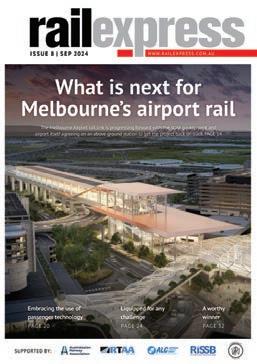
Published by:
379 Docklands Drive
Dockalnds, VIC 3008
T: 03 9690 8766
www.primecreativemedia.com.au
Publisher John Murphy
E: john.murphy@primecreative.com.au
Chief Operating Officer
Christine Clancy
E: christine.clancy@primecreative.com.au
Managing Editor
Lisa Korycki
E: lisa.korycki@primecreative.com.au
Editor Josh Farrell
E: joshua.farrell@primecreative.com.au
Business Development Manager
Alex Cowdery
M: 0422 657 148
E: alex.cowdery@primecreative.com.au
Client Success Manager
Salma Kennedy
E: salma.kennedy@primecreative.com.au
Art Director
Michelle Weston
E: michelle.weston@primecreative.com.au
Head of Design
Blake Storey
E: blake.storey@primecreative.com.au
Design Daniel Truong
Subscriptions subscriptions@primecreative.com.au
www.RailExpress.com.au
The Publisher reserves the right to alter or omit any article or advertisement submitted and requires indemnity from the advertisers and contributors against damages or liabilities that may arise from material published.
© Copyright – No part of this publication may be reproduced, stored in a retrieval system or transmitted in any means electronic, mechanical, photocopying, recording or otherwise without the permission of the Publisher.
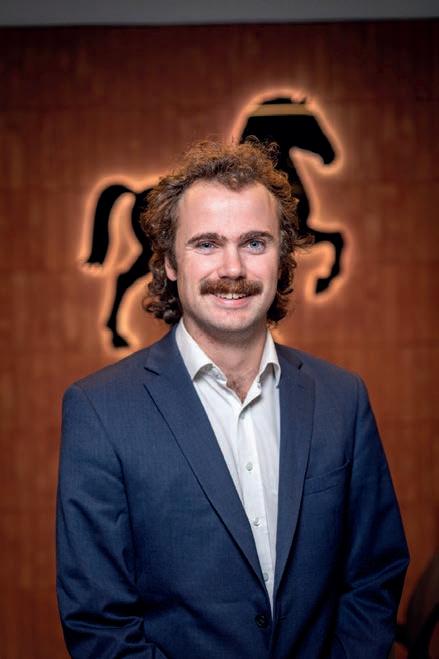
Josh Farrell Editor - Rail Express
The sector currently has such a flurry of work it is almost impossible to keep up with. The Sydney Metro project is rushing along with major milestones being reached regularly. The City line is a very exciting addition to the city’s transport network.
This city section, of what will be known as the M1 Northwest and Bankstown line, will include an additional 15.5-kilometre rail line extending the North West line from Chatswood, below the harbour and through the Sydney CBD, to Sydenham.
The Sydney line is just one example of the power of rail in improving a city’s transport options. Cross River Rail in Brisbane, the Metro Tunnel in Melbourne and METRONET in Perth are all examples of state’s improving the rail networks for generations to come.
Too often early in this millennium or throughout the 1990s did we hear of rail lines closing, removing access to reliable, cost-effective modes of transport for residents.
A prime example of the importance of returning rail services to communities was the celebration of 20 years of rail services to Ararat. Rail Express explores this occasion further in this edition.
Moving forward, it will be critical that we do not rest on our laurels when it comes to rail networks across the country. We should shrewdly invest in measured improvements and better access for residents.
Examples of this sort of rail expansion have been seen in Adelaide, with the opening of the Port Dock rail line. The line has been unused since 1981 and is close to being opened again to service communities in Port Adelaide.
This type of investment does not rely on the massive expenditure needed to lay new track but allows the government to
install updated signalling and complete required works to get the line up to current specifications.
I look forward to seeing what works will occur over the coming years and implore government to make smart investments to steadily improve rail networks.
This month the Rail Express team has had a number of enjoyable conversations while compiling the September edition.
In an insightful feature, Treaven Martinus cast his eyes forward to look at the future of the company, while also reflecting on his successes over the past 19 years.
The GrainGrowers association explored how to assist the industry with the movement of grain on our networks. Rail Express dived into the report.
Tony Coen was recently awarded an Order of Australia Medal for services to Heritage Rail and Pipe Band music. He explained his time in rail preservation and what he wants to see for the future of Tasmania’s rail network.
Our cover story unpacked the Melbourne Airport rail link, what the recent developments mean and what is in store for the exciting addition to the city.
Wellness in Infrastructure is looking to support mental health in the construction industry, and we learnt more about the diligent work being done to support the sector.
This month also includes comments from the ARA, RISSB, RTAA and the PWI.
Happy reading!
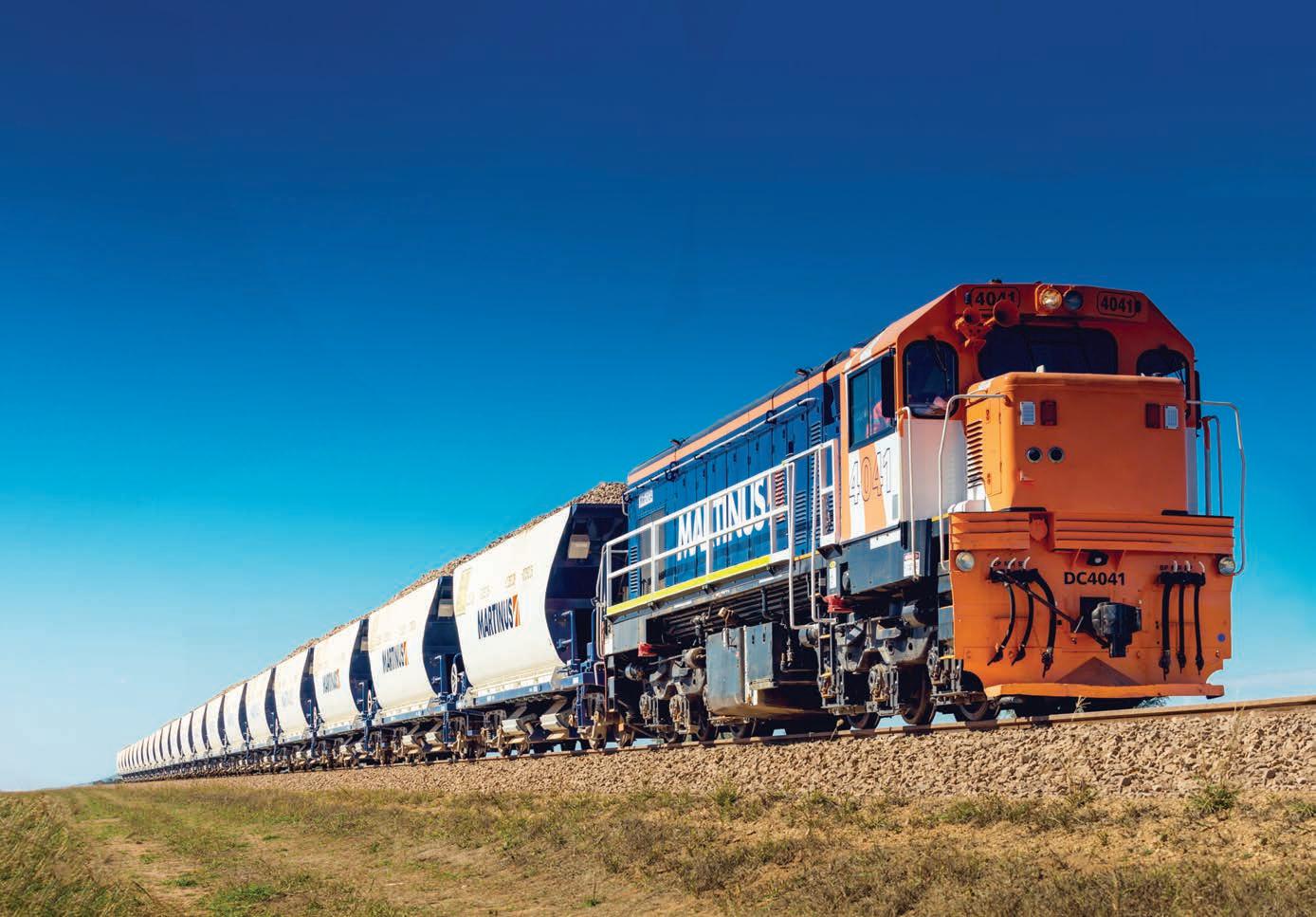
joshua.farrell@primecreative.com.au



Building the #NextGenRailways of tomorrow
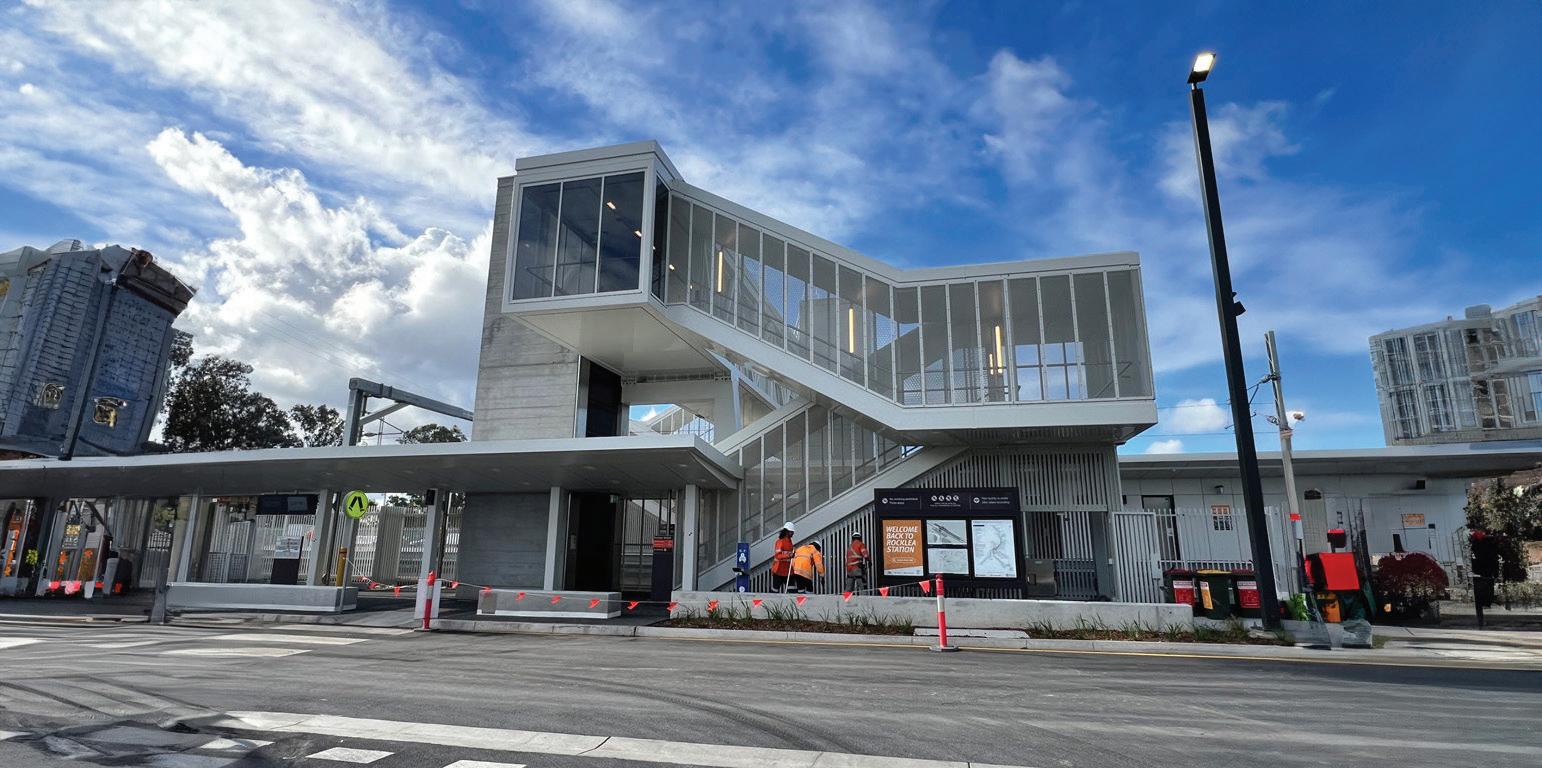
Features include new station buildings, an extra platform, pedestrian overpass, three lifts and switchback stairs, improving access for all passengers.
The ‘park ‘n’ ride’ has also been repaved to include better designed accessible parking, and drop-off and pick-up facilities. There’s also a new enclosed storage shelter for up to 40 bicycles.
The new Rocklea station was rebuilt as part of Cross River Rail works. Burpengary and Bundamba stations are also being rebuilt as part of Queensland Rail’s Station Accessibility Upgrade Program and will reopen soon.
It’s all part of the Queensland Government’s plan to expand, improve and modernise Queensland’s rail network, meet the increasing demands of the growing state and prepare for the Brisbane 2032 Olympic and Paralympic Games.
Minister for Transport and Main Roads Bart Mellish said the government knows how important a modern and reliable rail network is.
“Rebuilding stations like this one at Rocklea means everyone in the community can use the station and take the train,” he said.
“Whether you use a wheelchair, push a pram or you’re travelling with luggage, these upgrades are for you. We want to make public
Yeronga and Fairfield stations already open to the public.”
More than $1.5 billion is being invested in station infrastructure across the Queensland Rail network including improvements to partial and full upgrades and new stations.
This includes Nerang and Wacol, Fairfield to Dutton Park, Nambour, Auchenflower and more recently Morningside, Lindum, Banyo, Bundamba and Burpengary stations.
These works include accessibility upgrades such as lifts to replace stairs, new overpasses, platform raising and resurfacing, car parks, public toilets, augmented hearing loops and ramps.
Other rail network improvements include upgraded lighting, enhanced CCTV coverage, bike lockers, new customer screens, and the construction of Queensland Police Service Railway Squad outposts and hubs.
Queensland Rail Chief Executive Officer Kat Stapleton said Queensland Rail has been proudly connecting communities for nearly 160 years and is committed to improving the network to make it more accessible, convenient and safe.
“Our biggest accessibility upgrade program ever is currently underway, bringing into the modern era six more stations – Buranda, Burpengary, Banyo, Bundamba, Morningside and Lindum,” she said.
across the network.
“The improvements have already, and will continue to, make a big difference in the lives of customers who use the rail network. They help everyone in the local community to use the rail network safely and without barriers.”
Stapleton said security and comfort are important to the organisation and upgrades like better lighting, enhanced CCTV coverage, bike lockers, new customer screens, and the construction of Queensland Police Service Railway Squad outposts and hubs improve everyone’s travel experience.
Rocklea is one of seven stations between Dutton Park and Salisbury being rebuilt as part of a rolling program being carried out by Cross River Rail, south of the project’s twin tunnels.
Cross River Rail is also building four new underground stations at Boggo Road, Albert Street, Woolloongabba and Roma street, a new year-round Exhibition station and three new Gold Coast stations at Hope Island, Pimpama and Merrimac.
A new campaign has also been launched by Queensland Rail to promote the significant work and investment in station upgrades across the network and will feature on billboards, in train posters, station signage, radio and social media.

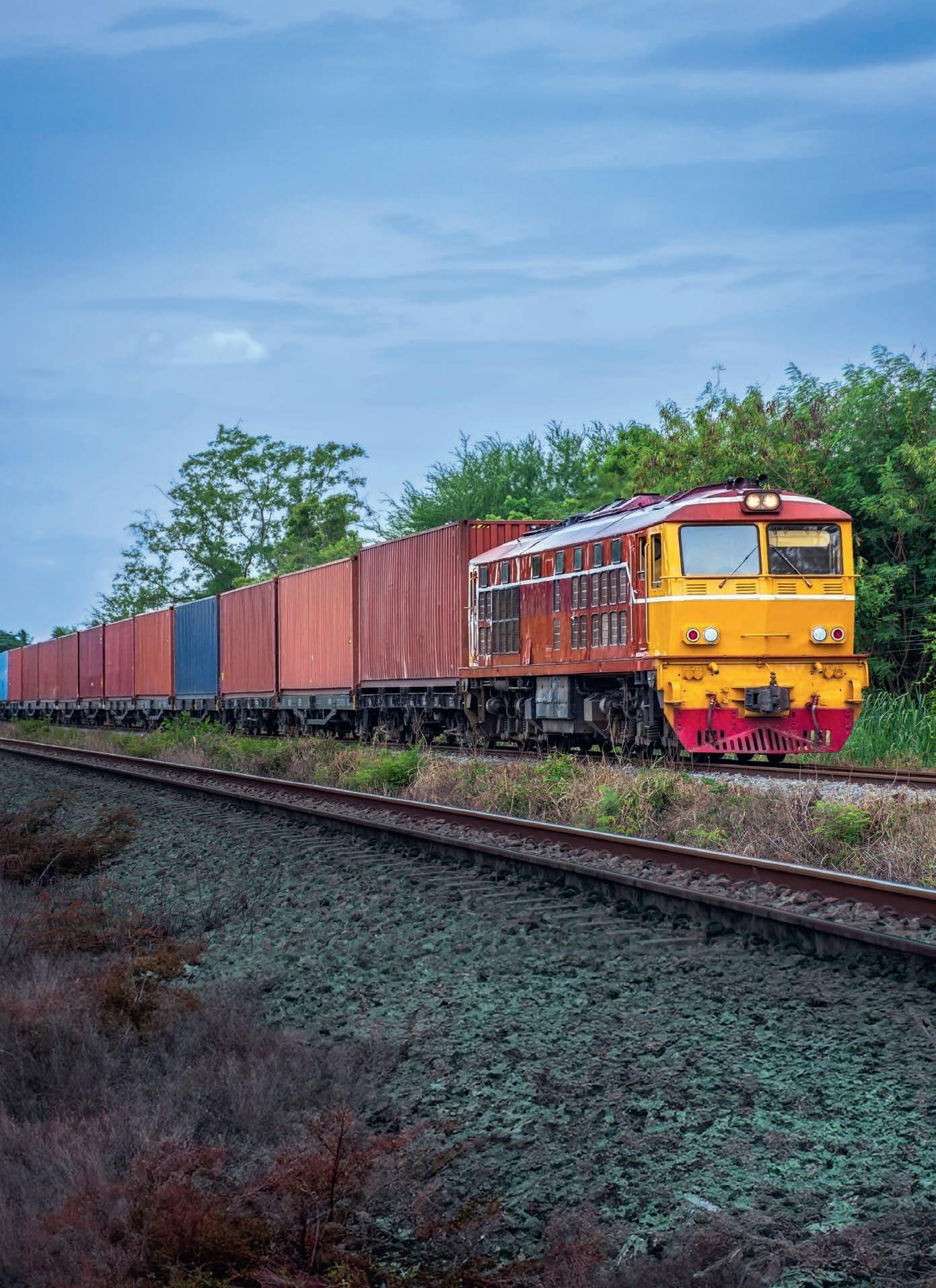
Liquip Victoria is one of Australia’s premier suppliers of Fuel Storage, Fuel Management systems, Dispensing products, Fuel loading arms and Equipment Service providers.


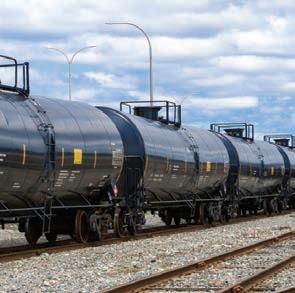
With a comprehensive Servicing team, we can keep your fuel system in pristine condition and install new systems to match your specific needs. Reach out to the


The Australasian Rail Directory is a comprehensive, all encompassing rail services directory, available both online and as a traditional hardcopy publication.
The Rail Directory is an industry driven project to provide a complete listing of all businesses involved in the Australasian, Oceanic and Asian rail industries.
This year’s rail directory will be revamped to become even simpler to use. Listings will be sorted into categories allowing users to easily find businesses working in each area of the rail industry.
With over 1000 listings from areas as manufacturing, signalling and maintenance, make your listing standout with a frame advertisement.
To ensure you are in prime position in this year’s rail directory contact Alex Cowdery today.
Free Listing
To ensure that the Australasian Rail Directory is comprehensive, we offer all businesses who operate or trade in the region one free listing in the directory.
Premium Category
Listing Available From $600 (+gst)
Double page, full page, half page and quarter page advertisement space also available.
To discuss the advertising opportunities available, please contact: Alex Cowdery on 0422 657 148 or email: alex.cowdery@primecreative.com.au

The Victorian Government has released designs for the removal of another level crossing in Melbourne’s west.
Minister for Transport Infrastructure
Danny Pearson has announced a new road bridge will be built over the Werribee Line at Maidstone Street, Altona – creating safer journeys, with more reliable travel times for the busy industrial area.
Freight and passenger train services on the Werribee Line are expected to increase in the future, meaning the boom gates will be down for longer –making this level crossing removal critical to keep the
The new road bridge will feature one lane in each direction with a pedestrian footpath and new lighting. Construction will start in 2025 and the level crossing is expected to be gone for good by 2027.
“The release of this design takes us one step closer to making the Werribee Line level crossing free by 2030 – changing the way people live, work and travel,”

crossing going in the west and invite the community to provide feedback to help shape the designs of this important project.”
Building a road bridge will avoid important underground utilities and the nearby protected Maidstone Street Grassland, helping to remove the crossing sooner. More than 14,400 vehicles and 48 trains travel through the level crossing each day where the boom gates are down for
more than 20 per cent of the morning peak. Locals can now share their feedback, which will help to refine designs for the Maidstone Street level crossing removal.
Early designs, online surveys and more information about community information sessions is available at the engage Victoria website.
The Victorian Government is removing 110 level crossings from around Melbourne by 2030, with 80 already gone.

The Lilydale Line is the first rail line in Melbourne to be level crossing free, and it was achieved a year ahead of schedule.
Acting Premier Ben Carroll and Minister for Transport Infrastructure Danny Pearson announced the level crossings at Dublin Road in Ringwood East and Coolstore Road in Croydon have been removed.
Since 2017, nine level crossings have been removed and six new stations have been built along the Lilydale Line, which is the second busiest line on the network and used by more than 72,000 passengers each weekday.
Removing these crossings means boom gates are no longer down for more than five hours in the morning peak, reducing frustrating delays for the more than 123,000 vehicles every morning.
Carroll said every single level crossing on this line is now gone, and it’s helping locals get home safer and sooner.
The new accessible East Ringwood Station will soon open to passengers and features lifts to each platform and parking for 460 vehicles.
Serious accidents and fatalities had previously been recorded at several of the Lilydale Line level crossing sites, including Union Road in Surrey Hills which was fast-tracked for removal after the death of two people.
Level crossings removed from the line include Blackburn Road, Heatherdale Road, Manchester Road, Maroondah Highway, Mont Albert Road, Union Road, Cave Hill Road, Coolstore Road and Dublin Road, Ringwood East.
Pearson said users on the Lilydale Line get to experience the very first level crossingfree line in Victoria which will mean the state will be able to run more trains more often.
These projects have delivered almost seven kilometres of new walking and cycling paths as well as new and upgraded open spaces – with more than 260,000 trees, shrubs and grasses planted.
The Cranbourne, Pakenham and Sunbury lines will be Melbourne’s next rail lines to be boom gate free in 2025, followed by the Frankston Line in 2029 and the Werribee Line in 2030.
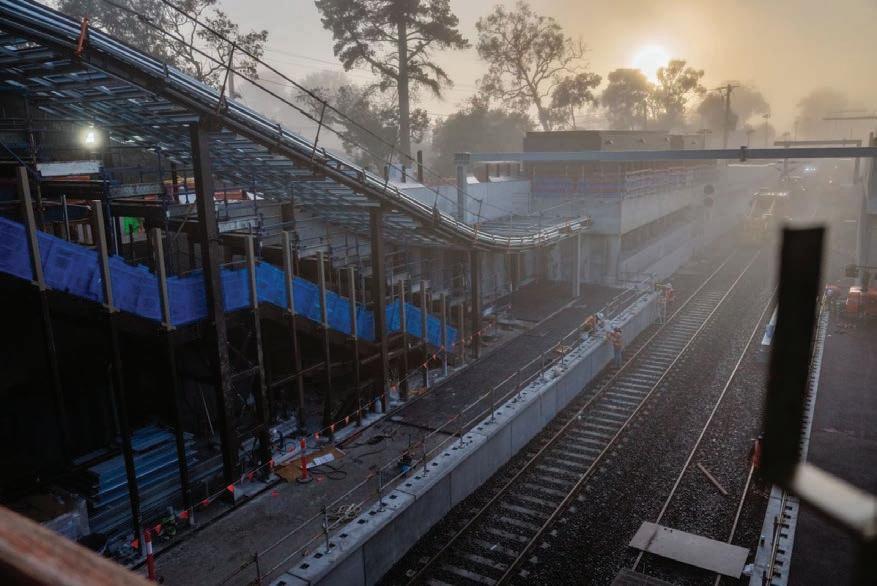
Nine level crossings have been removed since 2017 and six stations have been built.
dangerous and congested level crossings across Melbourne by 2030, with 82 already gone for good – helping Victorians get home safer and sooner.

KiwiRail will have people and machinery working on the Northern Diversion freight line between Masterton and Pahiatua, getting it ready for the temporary return of freight locomotives at the end of this year.
It has been nearly 10 years since the line last carried one of KiwiRail’s freight services. It’s expected to reopen between 27 December 2024 and 9 February 2025 while the Masterton to Wellington line is closed for major upgrade work.
KiwiRail Program Director Andy Lyon says bringing the Northern Diversion back into service temporarily will help keep trucks off
“Instead of sending logs by truck over the Remutaka Hill during summer when there is already lots of traffic on the road, we have made the call to bring the Northern Diversion line into use. That means taking logs the long way around from Wairarapa to Palmerston North, and back down the Kapiti Line to Wellington,” Lyon said.
“Over this summer there’ll be at least one freight service per day on the Northern Diversion, shifting the equivalent of 72 truckloads of logs, which means safer roads and less emissions.
“Keeping the line in good working order
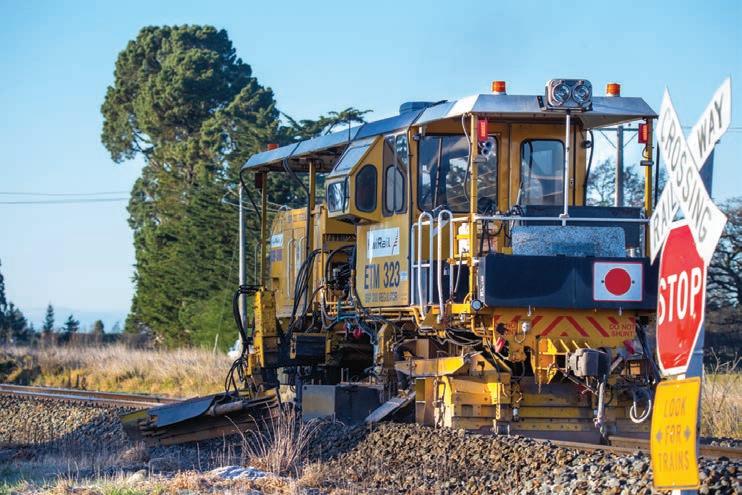
Passengers are catching trains from new second platforms at Bunyip and Longwarry stations after a major construction blitz in Victoria’s Gippsland region.
New infrastructure between Pakenham and Drouin, delivered as part of the Gippsland Line Upgrade, was made ready for service in May and June while coaches replaced trains.
More than 575 crew members worked a total of 85,000 hours, carrying out complex signalling work, safety testing and driver training.
The new second platforms at Bunyip and Longwarry have improved journeys for passengers and provides V/Line with more operational flexibility, boosting reliability.
can always get it up and running at short notice should something happen to the main trunk line.”
KiwiRail work crews are currently carrying out maintenance, clearing vegetation away from the tracks, replacing sleepers where needed and inspecting all of the rail bridges along the line.
“Over the next few weeks, we will be starting work on the overbridge at Eketahuna, which needs a bit of a facelift to carry the loads our freight trains will introduce, as well as replacing old sleepers in locations where they have started to decay,” Lyon said.
He said the crew will be giving extra attention to level crossings to make sure they are in perfect working order and are fully visible, with good signage in place, before the first test train comes through in October.
“We’re mindful that people won’t be used to seeing trains passing through their towns. Daily service and travel times will vary based on demand, so it’s really important that people are super vigilant around tracks and crossings,” he said.
“We’re looking forward to working with communities to make sure people know what’s happening and there is plenty of information out there about safety around trains and level crossings in particular.”


The future of the Gold Coast Light Rail is officially set in stone as Gold Coasters will now see rail installed in the centre of the Gold Coast Highway in Miami, as part of the Stage 3 Gold Coast Light Rail works.
The section south of Nobby Beach will be installed first, closely followed by another section in Mermaid Beach. In total, 28 kilometres of rail will be installed along the Stage 3 route, with 14 kilometres expected to be in place by the end of 2024.
The rail works will move significantly quicker than the utility upgrades below the ground, which have been occurring along the alignment since late 2022.
Acting Federal Minister for Infrastructure, Transport, Regional Development and Local Government Murray Watt said the first piece of rail installed in the centre of the Gold Coast Highway for the Light Rail Stage 3 project is an exciting milestone.
“This project is a prime example of the Federal Government’s commitment to delivering nation-shaping infrastructure, which will open up affordable public transport for Gold Coasters, while cutting congestion,” he said.
Rail works will require changes on the Gold Coast Highway and nearby side streets from Broadbeach to Miami, along the Stage 3 corridor. Motorists travelling in the area are reminded to drive to the conditions and continue to follow directions.

has reached another milestone with the first section of track in the light rail extension officially set in stone.
“This public transport link over its lifespan will potentially serve hundreds of millions of people from the Gold Coast and across the world,” he said. “
The track is in the ground, we have five brand new trams added to the existing fleet, and we’re going to see plenty more work above and under the ground taking shape from now into next year.
“We know there may be short term challenges during construction, but we know
The Suburban Rail Loop Authority (SRLA) has announced a consortium to build the 10 kilometres of twin tunnels between Glen Waverley and Box Hill.
Consortium Terra Verde is the preferred bidder for the second SRL East tunnelling contract.
The global consortium of WeBuild S.p.A, GS Engineering and Construction Australia and Bouygues Construction Australia has deep experience in Victoria and overseas, including the Metro Tunnel Project, North East Link, the Forrestfield-Airport Link in Perth and Copenhagen’s Cityringen Metro.
Detailed negotiations are now underway, and the Tunnels North contract will be awarded later in 2024.
This significant milestone follows the award in 2023 of the Tunnels South contract to Suburban Connect – for tunnelling between Cheltenham and Glen Waverley. Suburban Connect has hit the ground running, with ground investigations and planning well underway ahead of the scheduled start of tunnelling in 2026.
running from Broadbeach south station to Burleigh Heads, eight new light rail stations and five light rail vehicles.
GoldlinQ Chairman John Witheriff said a significant amount of the rail works, including concrete pours, will be undertaken during the day. As summer approaches, there will be a requirement for night works due to the curing time for the concrete.
“We have been pleased to see how drivers have navigated the road changes so far,” he said. “The traffic changes are unavoidable during construction, but overall driver behaviour has been excellent.”


The Linewide package to build the high-tech fleet of SRL trains, fit out the tunnels, install signalling, and operate and maintain the network will be awarded in 2025 – and two contracts to build the six new underground stations will be awarded from 2026.
Construction of SRL East between Cheltenham and Box Hill is powering ahead, with construction underway at all six station
sites and the stabling facility in Heatherton. SRLA is also planning for the neighbourhoods around each station, with extensive community consultation informing structure planning for each area. Draft Structure Plans will go on public exhibition soon.
SRL will deliver more public transport and housing options in the right places, with a long-term vision for 70,000 more homes and 230,000 extra jobs in the areas around the six SRL East stations.

Building the long-awaited Maldon-Dombarton line to connect Port Kembla to the Macarthur region would be a game-changer for both passenger and freight rail in New South Wales, according to the Rail, Tram and Bus Union (RTBU).
RTBU New South Wales secretary Toby Warnes said developing the dual-track railway that meets the main southern line at Maldon, which was abandoned in the 1980s, is an example of the kind of rail projects the State Government should be looking at elsewhere.
The union will urge the New South Wales Government to commit to developing regional rail throughout the state.
“The New South Wales Government should be focused not just on reopening closed rail lines, but also on finding opportunities for rail expansion into other areas of the state,” Warnes said.
“The Maldon-Dombarton line is the perfect example of a rail line that needs to be opened. At the moment, we have two huge growth regions without any real connection to each other.
Construction began in the 1980s but was abandoned soon after.

and efficient public transport service.
“Our rail freight is also limited by a lack of rail infrastructure. When you consider that rail is the cleanest, greenest mass-transit system we have available, it makes complete sense to focus efforts on maximising our use of it.”
in New South Wales has surged as fuel prices increase, and people have realised the potential in their own backyard,” he said.
“It is time to shift thinking on regional rail and identify both previously closed rail lines for refurbishment, as well as opportunities for new regions to be serviced by this transport vital infrastructure.”

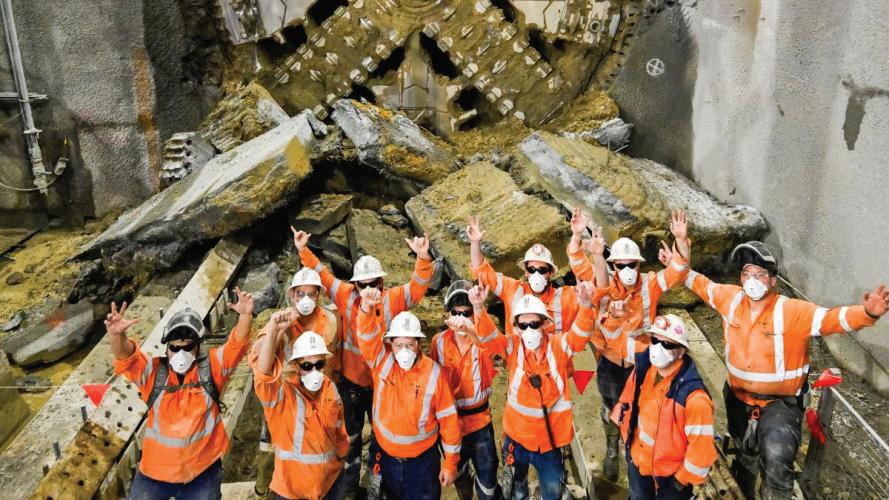
Greater Western Sydney is now home to landmark 9.8-kilometre twin metro railway tunnels, with major tunnelling officially complete on the city-shaping Sydney Metro –Western Sydney Airport project.
These tunnels are set to become the transport spine of the Greater West.
The historic milestone was reached after tunnel boring machine (TBM) Marlene arrived at the St Marys Metro Station site and achieved the final tunnel breakthrough for the project.
The mega machines spent 14 months building two separate sets of tunnels at either end of the alignment. The job required the excavation of 1,863,460 tonnes of material, enough to fill 300 Olympic-sized pools, and the installation of 69,966 concrete segments to line the new tunnel walls.
TBMs Marlene and Catherine carved out the 4.3-kilometre tunnels from Orchard Hills, under the M4 Motorway and the
Great Western Highway to reach St Marys.
TBMs Eileen and Peggy constructed the 5.5-kilometre tunnels from Airport Business Park, underneath the new Western Sydney International Airport, to Aerotropolis.
The final TBM breakthroughs occurred in quick succession:
• TBM Catherine completed the first tunnel at the St Marys site on 20 May 2024.
• TBM Eileen broke through at the Aerotropolis site on 29 May.
• TBM Peggy made the penultimate breakthrough for the project and arrived at the Aerotropolis site on 7 June.
• TBM Marlene made the final breakthrough at the St Marys site on 20 June 2024.
With tunnelling complete, the TBMs will be dismantled, washed and lifted by tower cranes onto trucks to travel to a storage location, before they are shipped back to the TBM manufacturer.
Work inside the tunnels will continue and involves completing the construction of 39 cross passages and preparing for tracklaying to begin.

Level crossings in and around Colac have received an upgrade to prepare for the introduction of modern and accessible VLocity trains.
Ten crossings in the Colac area have been upgraded as part of Stage 2 of the Warrnambool Line Upgrade.
More than 20 crew members worked to upgrade train detection technology at the level crossings since construction in the area began in 2023.
Axle counters – required to make the crossings compatible with VLocity trains – were installed at each site, with work including trenching and cabling.
Crossings at Larpent and Warrowie roads received an added safety boost with the installation of boom gates, lights and bells.
Similar upgrades were completed at the Deans Creek Road level crossing as part of the first stage of upgrades to the Warrnambool Line in 2020.

at Church Street, Hart Street, Armstrong Street, Cants Road, Colac-Ballarat Road, Flaxmill Road, Colac-Forrest Road / Queen Street and Pyles Road, are now ready for the introduction of VLocity trains on the line later in 2024.
The works provided an economic boost to Colac and the surrounding region, with workers using local accommodation, cafes,
being completed as well.
Other works set to occur on the Warrnambool Line include 2.2 kilometres of new track for the Boorcan crossing loop to improve service reliability. These works will allow a fifth weekday return service for residents.

Perth’s public transport network is being set up for generations to come, with major technology and infrastructure upgrades that will eventually see train services running every three minutes.
A 10-year $1.6 billion contract has been awarded to AD Alliance – Alstom Transport Australia Pty Ltd and DT Infrastructure Pty Ltd – to design, supply and build Perth’s High-Capacity Signalling (HCS) project.
HCS will replace and upgrade the signalling and train control systems on Perth’s rail network, allowing more trains to run more often and ultimately increasing capacity by 40 per cent.
Work will include:
• upgrading signalling along the total length of the Transperth train network (500 kilometres)
• installing more than 7000 transponders enabling precise train location
• introducing new in-cab signalling equipment for 125 trains including the Prospector and Australind regional trains
• improving passenger information on more than 600 displays on 89 stations across the network
• installing more than 250 kilometres of electrical conduit.
The project is expected to create 230 direct jobs and support 750 jobs overall.
Darren Crichton spoke about the project.
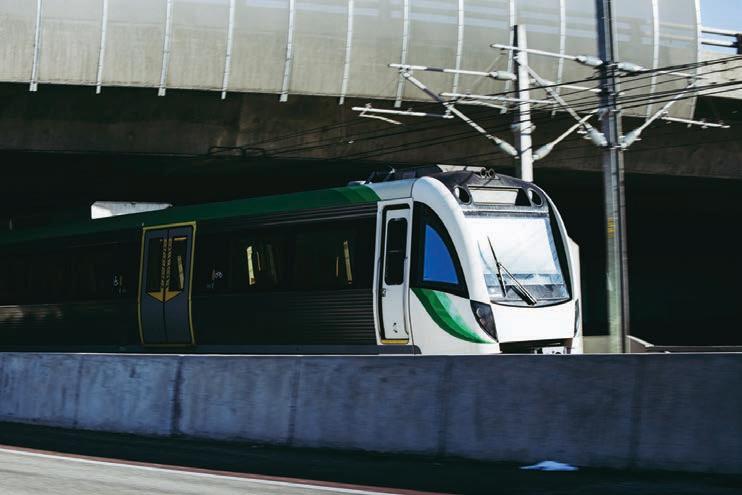
“With several METRONET projects nearing completion, Perth’s upgraded rail network means residents and visitors are more connected than ever before,” he said.
“The High-Capacity Signalling program will ensure that this capability is fully utilised, running more trains more often.”
The HCS control technology will be housed in the new state-of-the-art Public Transport Operations Control Centre (PTOCC) in East Perth, which will be a
incident management.
The HCS project is funded by both the Australian and Western Australian governments and will be delivered in stages over the next decade to minimise disruption to train operations.
The Australian Government is committing $300 million to stage one of the project.
The project has been identified by Infrastructure Australia as a priority since 2020.

The Melbourne Airport Rail Link is edging closer to getting underway. Rail Express has dived into the project to understand where it stands.

Opened in 1970 and serving Melbourne for more than 50 years, Melbourne Airport is the second busiest in the country – it has welcomed more than three quarters of a billion passengers since opening – but remains connected to the CBD by road only, with no train link.
Based in the city’s outer suburbs, the airport is 24 kilometres from the CBD by road. Currently, the most efficient mode of transport to reach the airport, for those not wanting to travel by car, is the Skybus. It departs from the Southern Cross railway station and costs $40 return.
The Melbourne Airport rail link has been discussed for nearly as long as the airport has existed. In 2018, the Victorian Government committed to constructing a link that would traverse through Sunshine station to the airport.
The Airport Rail Link will connect Victoria’s entire regional and metropolitan rail network to the airport and support up to 8000 jobs during construction.
Airport trains will travel through the Metro Tunnel, providing passengers with
a 10-minute turn-up-and-go service from Melbourne Airport and a continuous journey of about 30 minutes into the CBD. Trains will travel through transport superhubs at Arden, Footscray and Sunshine about every two to three minutes, creating jobs and development opportunities in these important precincts.
New stations will be constructed at the Airport itself and Keilor East. The line will connect at Sunshine station, then travel through the Metro Tunnel into the CBD before connecting onto the Cranbourne and Pakenham lines.
Passengers on all City Loop trains will be able to connect to airport trains at Flinders Street and Melbourne Central stations.
The majority of Victorians will be able to get to the airport with just one interchange while residents in the south-eastern suburbs will be able to get to the airport without changing trains. Melbourne’s west will also have direct airport access via Sunshine Station, or Footscray Station for passengers on the Werribee and Williamstown lines.
Passengers from the regional centres of Geelong, Ballarat and Bendigo will travel
to the airport via a single interchange at Sunshine, while Gippsland passengers will be connected via a choice of interchanges along the Cranbourne and Pakenham lines.
It is expected that Melbourne will be home to eight million people by the year 2050 and the city’s transport network will need to cater for about 10 million more trips a day — an increase of more than 80 per cent.
With the upcoming suburban rail loop and the soon to be completed Metro Tunnel, the city has begun preparation for this growth. Melbourne Airport will also be front and centre in supporting this growth as Melbourne Airport Chief Executive Officer (CEO) Lorie Argus explained.
“With an estimated 45 million travellers a year predicted to be using our airport when the third runway opens, the rail link will support a massive increase in passenger numbers and billions of dollars in additional economic activity for Victoria,” she said.
“Melbourne Airport would welcome the immediate recommencement of discussions

with government over the airport station with an initial focus on its design, the sequencing of construction works and redress for the land required for the above ground option.
“The airport currently welcomes around 100,000 passengers a day and is the largest employment hub outside of the Melbourne CBD. More than 210,000 passengers will use the airport every day in less than 20 years and the expanded airport is forecast to add $5.9 billion to the state economy every year and support 51,000 jobs.”
The Australasian Railway Association (ARA) has shown its support for the project.
Chief Executive Officer Caroline Wilkie
described the Melbourne Airport Rail link as a critical piece of transport infrastructure for Melbourne. It’s been on the government’s agenda for more than 30 years, with both the Commonwealth and Victorian governments committing funding in 2018.
“The ARA is very pleased to see the project back on track. However, it will be critical that this project receives bipartisan support to ensure meaningful progress as soon as possible for the benefit of the community and economy,” she said. “Melbourne is the only major capital city in Australia without a direct rail link to the airport despite being the fastest growing city.

“The rail link to the airport will not only provide an important public transport link for commuters and business but will also support the local tourism industry.”
A spokesperson from Melbourne Airport explained why this Airport Rail Link matters.
“The growth expected at Melbourne Airport over the coming decades will bring billions of dollars to Victoria and provide jobs for tens of thousands of people,” the spokesperson said.
“Airport Rail will be a vital link to the city centre and local communities for millions of travellers each year.
“Melbourne Airport is the second largest employment hub outside of the CBD, with an indirect workforce of more than 17,000. A lot of that workforce are young people who work in our retail stores across the airport, and we know getting to and from the airport can be challenging and costly for them.
“A rail link will provide essential public transport infrastructure for an area of Melbourne that desperately needs it and will give our staff another alternative for how they get to and from work.”
Former Queensland transport department director-general Neil Scales was tasked with assisting to get the stalled project back underway in April 2024. He handed down his findings in late June.
He made a number of recommendations and stated the project remains viable and necessary, and has support from the Australian and Victorian governments, Melbourne Airport operator APAM, and the public. He also reported that it is possible to

find a solution to the location of the station at Melbourne Airport.
The report made three main recommendations, including that the Commonwealth and Victorian Government proceed with “no regrets” work at Sunshine Station to transform it into a major transport hub and capitalise on the early works already completed for the Melbourne Airport Rail Link.
The Commonwealth will commence discussions with the Victorian Government on the proposal to upgrade capacity at Sunshine Station, with funding to be formally considered once costs and scope are finalised.
The mediation process was undertaken to find a resolution between the Victorian Government and APAM as to the location of the station. The state had advocated for an above ground station, while the airport operator’s preference was for a
The report recommended against further Commonwealth and State consideration of an underground option at this time. Should APAM wish to progress with the option of an underground station, it was recommended that it produce a suitable and comprehensive business case, so that key stakeholders can examine the proposal in detail.
APAM has said it will support an aboveground station for the proposed airport rail line to ensure the public transport link is in place for the millions of additional passengers that will use the gateway when the third runway is opened.
Argus said the airport recognised the need to get on with the rail link in the interests of travellers, the city, Victoria and the airport’s expansion.
“Victorians have waited long enough for an airport rail line,” she said.
“We will work with the Victorian
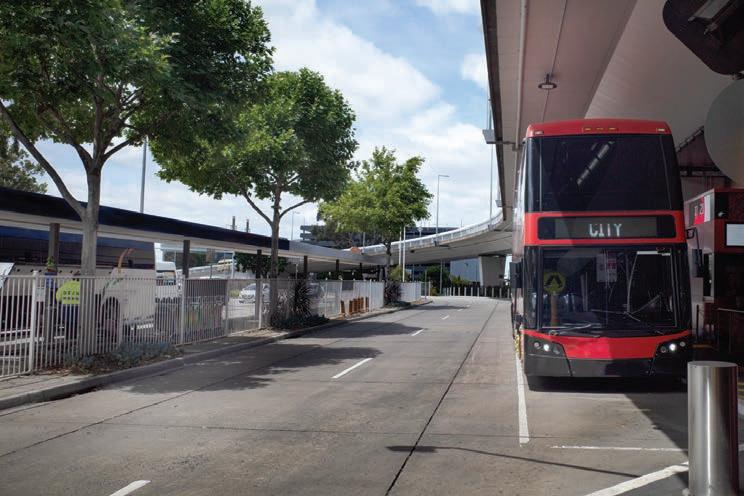
above-ground station at the airport so the rail line can become reality. While Melbourne Airport has consistently advocated for an underground station, we are prepared to compromise on our position to ensure we have more transport options in place for the millions of new passengers that will visit Victoria and the airport precinct’s expanding workforce.”
All stakeholders have confirmed a new premium station will be built at Melbourne Airport. Design of the new station and its connections to the Airport terminals, and the future Suburban Rail Loop, is underway.
A Melbourne Airport spokesperson explained what APAM expects the new airport station to look like.
“The elevated station would interface with our current Terminal 1,2,3 car park, but the exact design is still to be worked through with the government,” the spokesperson said.
“We know many of our travellers have accessibility or mobility needs so things like wide, covered walkways will be a focus for us throughout the design phase.”
The State Government has said Melbourne Airport Rail will likely be delayed by at least four years.
A Melbourne Airport spokesperson said the timing of the project is a matter for the State Government.
“We know that to support the forecast passenger growth after the third runway opens, we will need all available transport options at the airport including the rail line,” the spokesperson said.
The impacts of constructing the Melbourne Airport Rail are far-reaching and include the redevelopment of the Sunshine Station
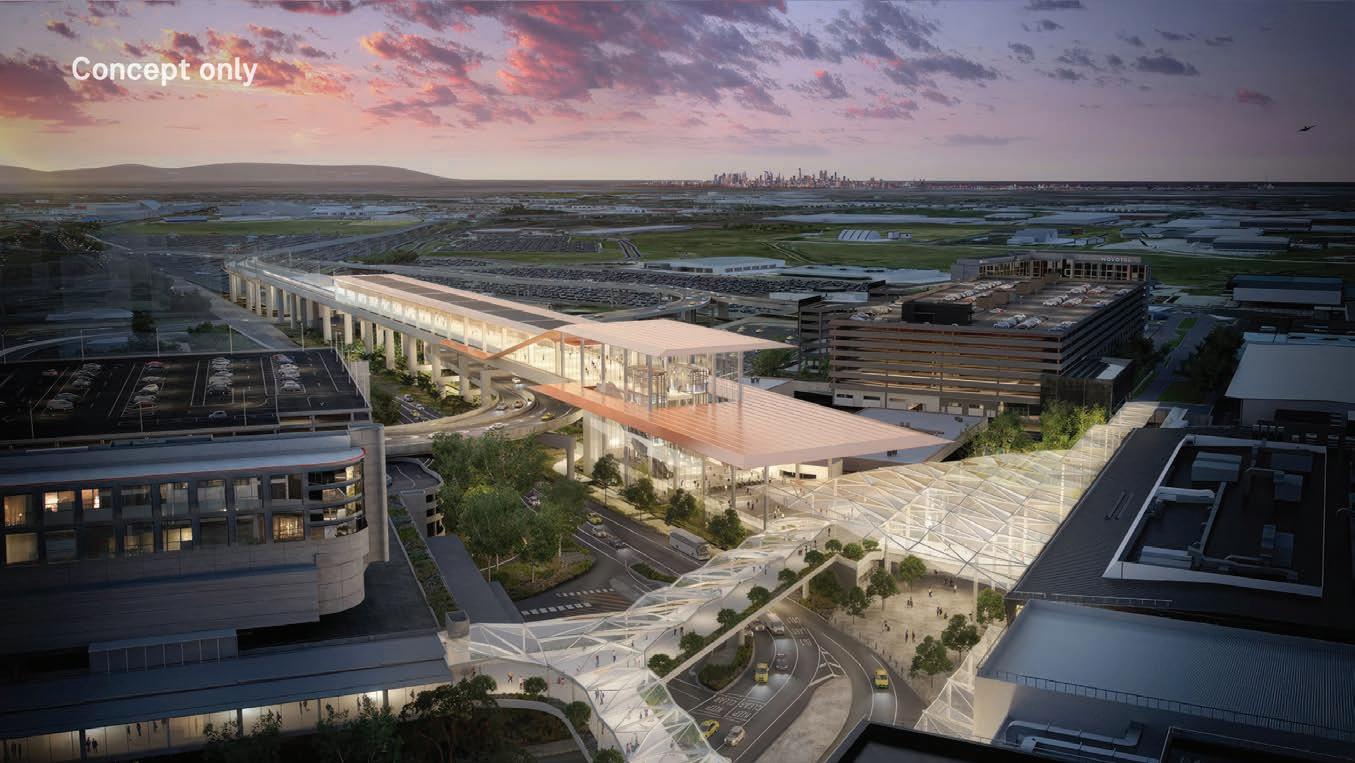
Precinct into a visual and iconic superhub, as well as the improved integration of a rebuilt Albion Station with the surrounding Albion Quarter, according to Brimbank City Council. A council report states that increased transport options will enable local residents to access services, facilities, programs and employment, and decrease the social and economic exclusion that can affect overall wellbeing, particularly in a highly disadvantaged community such as Brimbank.
The council welcomed the Federal Government’s decision in November 2023 to recommit $5 billion previously promised for the construction of the Melbourne Airport Rail.
Sunshine is positioned to become the major hub and interchange between metropolitan and regional rail services and a gateway to Melbourne Airport.
The Sunshine Super Hub and Airport Rail Link are identified as providing the opportunity to deliver the infrastructure needed for the Western Rail Plan, which is intended to support the growing western suburbs of Melbourne with the Airport Rail Link and fast rail between Geelong and Melbourne.
Melbourne Airport Rail will deliver a range of upgrades to Sunshine Station including:
• a new, accessible second concourse with escalators and lifts for better passenger connections between regional, metropolitan and Melbourne Airport trains
• platform extensions and better access to existing platforms including more weather protection
• extra ticketing gates at the main entrance to improve accessibility for people,
including those with luggage
• double the number of lifts in the station to improve accessibility and ease of movement for travellers with luggage. These improvements to Sunshine Station will complement other investments that are expected to make Sunshine a key transport precinct and jobs centre for western Melbourne.
The Airport Rail Link will not be the only link connecting the airport to Melbourne’s train network.
The Suburban Rail Loop North Section will also travel through Sunshine, connecting Melbourne Airport to Victoria’s regional and metropolitan train network for the first time. It will provide direct access to Melbourne Airport from more than 30 stations without the need to change trains.
The project will deliver 5100 additional direct local jobs during construction of SRL North, with a total of up to 24,000 jobs supported across the Victorian economy to deliver both SRL East and SRL North.
Strategic development, major investment and new local projects in the broader areas around SRL North stations will also generate and support more jobs closer to where people live, diverse and affordable housing, and services such as schools, parks and playgrounds.
Seven brand new stations are proposed for SRL North at Doncaster, Heidelberg, Bundoora, Reservoir, Fawkner, Broadmeadows, and Melbourne Airport. Station locations are preliminary and will be confirmed as the planning and development of SRL North progresses.
Broadmeadows is set to become a
transport super hub, with a connection for regional passengers and trains travelling in four directions.
By the 2050s, around 8500 regional passengers are forecast to travel through the superhub station each day, and more than half of all passengers travelling on Hume corridor services will interchange at Broadmeadows.
SRL North will deliver better access to tertiary education, employment and business opportunities right across Melbourne’s middle suburbs and will give many Victorians a direct connection to Melbourne Airport for the first time.
The new rail line will slash public transport travel time from Broadmeadows to the airport by almost half, and journeys will be easier, more reliable and more comfortable particularly for those travelling with luggage.
SRL trains will be fitted with convenient and secure luggage compartments. Better connections to the airport will also improve travel between regional, interstate and international markets. This will expand opportunities and boost the business and tourism potential of regional Victoria.
While SRL East (Cheltenham to Box Hill) is the immediate focus for delivery, early planning and development on future stages continues. SRL North is expected to be complete by 2053.
While the Airport Rail Link’s details are being finalised, the State Government stated early works and other works already funded are continuing. This includes the utilities relocation program involving telecommunications, water and electricity services, which will be completed by the end of the year.

Martinus has continued to grow at an impressive rate since its inception, but it is what is on the horizon that has kept its founder excited.
Founder and chief executive officer Treaven Martinus has always had big ideas and the position construction company Martinus finds itself in today is thanks to this desire to challenge industry conventions.
His decision to go out alone and start his own company was a successful one. In 19 years Martinus has grown into a leading rail infrastructure construction company in Australia, New Zealand, the United States, and Chile.
The company is now delivering major projects including Inland Rail, City Rail Link, Carmichael rail network and the Murray Basin Rail Project in Australia as well as in international markets.
Treaven said the keys to the company’s success are simple. Hire the right people

for the right jobs and foster a culture that empowers them to excel.
“You have to get the right people to implement your goals and reach success as a team and then as an organisation,” he said.
Treaven said the Martinus Way – 11 pillars that centre around respect, action, integrity and leadership – have been central to the organisation’s success.
“It started with six [pillars] but then a Sunday night five years ago after we had expanded into New Zealand, I felt that we needed a refresher. At about 10 o’clock I jotted down another four to take us up to 10 but I felt we were still missing one.”
The final pillar that Treaven identified was a ‘no fools’ policy. This enshrined the company’s emphasis on preventing poor
behaviour from affecting the performance and wellbeing of staff and their teams.
For Martinus these pillars are more than corporate jargon and are the core differentiators for how it works internally, with delivery partners and clients.
There’s sound business logic to the emphasis on culture, as Treaven explains:
“You cannot break into the market if you are doing what everyone else is. The incumbents will continue to win the work and you are never going to be selected if you are doing the same as everyone else.”
LAYER CAKE GROWTH MODEL
Martinus’ growth journey can be broken down into seven-year phases. The first seven years focused on product supply, the next

the past five years has been major projects.
Treaven described it as a layer cake growth model, in which each new layer of the business is built on a foundation formed by the success of the preceding period of expansion. Each preceding phase forms a solid base for the company’s next stage of growth, while each new division or capability forms becomes the foundation for the next stage of growth.
“The first seven years we supplied turnouts with a unique business model. We owned the design and the intellectual property, and through that we outsourced the manufacturing and utilised our supply chain knowledge to deliver this for the rail industry,” Treaven said.
“We then moved into the services and maintenance space, beginning with very small operations and expanding onto large projects across Australia.”
The latest period of growth has been the transition into delivering major projects. This has necessitated the expansion of its in-house design and engineering capabilities to win projects such as City Rail Link.
“You cannot break into the market if you are doing what everyone else is. The incumbents will continue to win the work and you are never going to be selected if you are doing the same as everyone else.”
Treaven Martinus, CEO Martinus
“The milestones along the way are things that I reflect on with pride but also look at for experience when we are transitioning and adding the next layer to our cake,” Treaven said.
“I always have a lot of ideas, but it’s always about having the right people when we are transitioning into new sectors.
“I have a great team around me who can have discussions that challenge each other to come up with how we can do things differently.”
As Martinus moved into major projects, Treaven understood it was critical to do
things differently. The company focused on a unique way of working with sub-contractors.
“We identified an opportunity to change the way we were tendering for projects compared to others in that space,” he said.
“In the past, contractors would tender for the work and then put the call out for subcontractors after they had won.
“We would identify our ideal subcontractors before tendering and take them along for the journey. We have a lot of the capabilities internally but by bringing them in early we can give a clear picture from the tendering process onwards.”
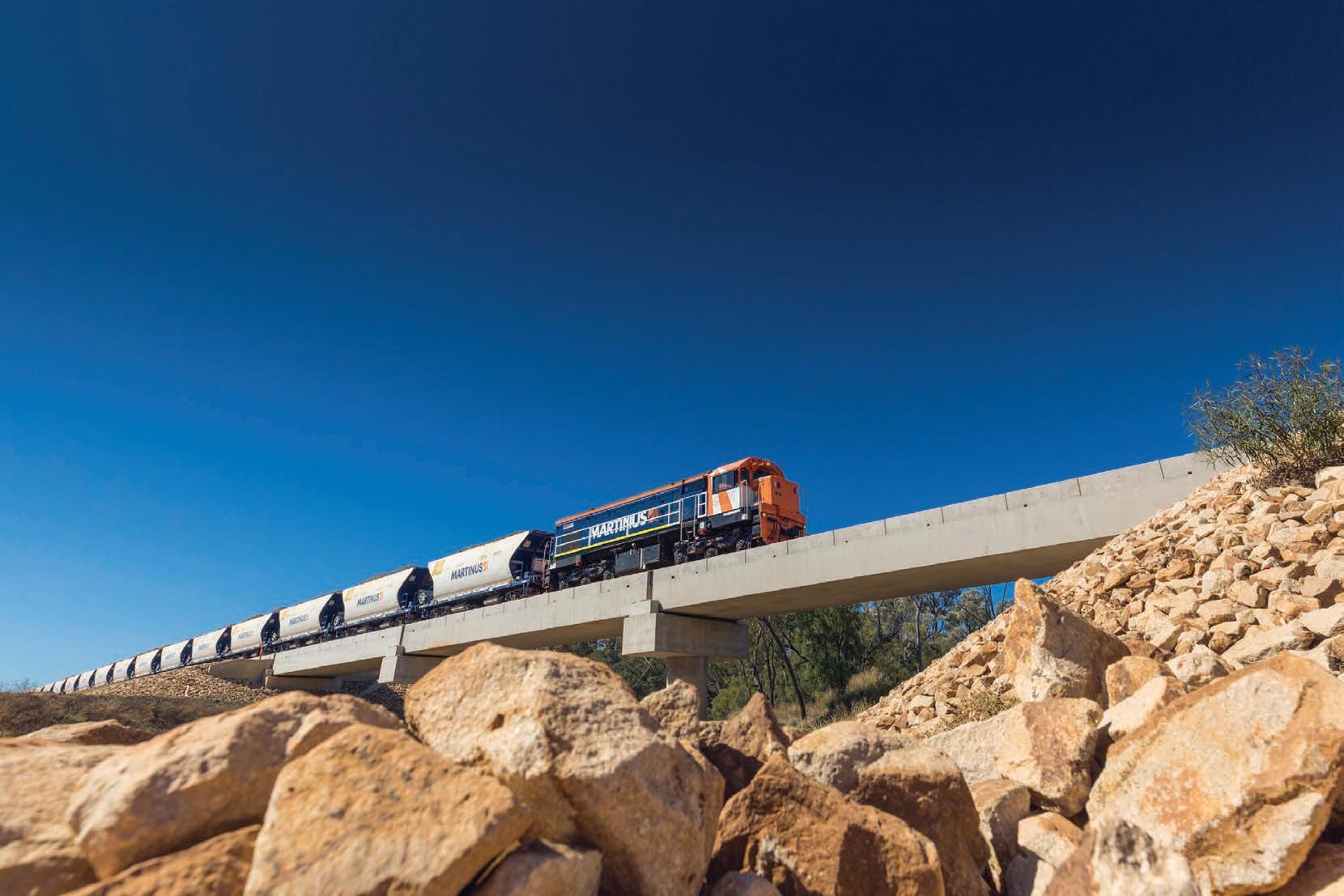
makes a move into a new space the organisation is looking to take the right team with it.
“You have to put the right people in charge of something when it is getting off the ground,” he said.
“We will start with our small teams and then try different things and then once it gains momentum, we will really invest in it.”
The next layer of the cake for Martinus will be a move into the haulage sector. It’s a transition that makes sense for a company that’s involved in moving a large volume of commodities by rail in its major projects.
“This was the logical next step and we are really excited for the work ahead,” he said. “A lot of the big mining companies are looking for efficient ways to move their products from pit to port. We are looking to better engage with our clients and the mining industry.
“For so many of these organisations, rail is not their focus so we can take that onus on ourselves and offer an end-to-end solution for these mining companies. We can
operate them to ensure they are maximising their capabilities.”
Treaven said that the focus is to start with what a client needs and develop a fit-forpurpose solution. The company will then bring its proposal to the table and establish whether that will work for the client.
“It is about ensuring it is an allencompassing solution and not just something off the shelf,” he said.
Another way that Martinus seeks to expand is with the development of its InfraPay platform, intended to support companies whose core business requires below-rail infrastructure but may not have the capital to fund such projects.
“We have the access to capital to deliver rail infrastructure and own it over a long period,” Treaven said.
“It is that pit-to-port solution that we want to be. There are stranded mine assets that can be in a region that doesn’t have the capital to invest in railway infrastructure.
can support that growth and access to nearby ports.
“It is a simple model of turning CAPEX into OPEX and getting projects off the ground. It goes hand in hand with haulage and it is exciting.”
The InfraPay model has been successful in the company’s operations in Chile, a country that has a large number of mining operations but very little access to railway infrastructure.
This platform will work alongside and drive the growth of the company’s haulage sector and Treaven expects to see it used in a number of markets in the coming years. The InfraPay model will allow Martinus to scale its work to any business regardless of the size of its rail network.
“The benefit of what we do, is we keep each stream of the business separate from each other and in their specific regions,” Treaven said.
“Our product offering is different to our construction offering and they can combine for a pit-to-port solution, but they can also operate independently.

“The teams can lean on the experience of other business streams to ensure success but the best projects are the ones in which we are completing the major project and then
Treaven said a growth mindset has been important to him and it’s what he has passed onto his team, across the business and each
“For us, it is about creating more opportunities,” he said.
“Creating opportunities by expanding into the United States, for example, or into Chile, taking our great team and our experience
“An example of this growth mindset was a team member recently approaching me in Brisbane as she was looking to relocate to the United States. It gave us the opportunity to get some solid experience in our
Treaven aimed to simplify the company’s operations throughout his time as CEO and one of these practices has been maintaining
“The main reason for this is we deliver projects and projects are not delivered from a location off site,” he said.
“I will travel around to different sites and work out of those sites, learning from the local teams. Corporate is a dirty word for us. We have our governance oversight of course, but we do not need to refer back to a head office to make our decisions.”

has been strengthening team members’ autonomy. Giving the team autonomy, coupled with accountability, ensures the company is operating efficiently and at the cutting edge.
“I always tell my team that no one is going to make bigger mistakes than the ones that I have made,” Treaven said.
“So don’t be afraid. A non-negotiable is safety but I encourage them to be at the cutting edge of what we can do.
“Mistakes are good, we can learn from them, grow and be better.”
When questioned about what challenges he expects to see on the horizon, Treaven chuckled and said that challenges are seen as opportunities in the organisation.
Treaven said the team has diversified geographically for a reason – to keep its railroad experience growing but also to ensure work continues long into the future.
“Infrastructure is booming in Australia, but it will not be booming forever so we pushed ourselves to expand,” he said.
“Looking for new areas in the railway space to make sure that we do not have all of our eggs in one basket.
“That will always be a challenge for us, and a focus will be to have a good runway of work. We will do that by maintaining our four markets.””



praised as one of the best networks in the world. The 10-line rapid transport network serves the urbanised areas of Hong Kong Island, Kowloon, and the New Territories.
The system encompasses 245 kilometres of railways, as of December 2022, with 179 stations—including 99 heavy rail stations, 68 light rail stops and one high-speed rail terminus.
MTR Corporation operates the large network transporting millions of passengers each day. Beyond efficient train operations, providing thoughtful and comprehensive
MTR is committed to ‘smart commuting’ –offering passengers convenient, personalised travel experiences. This customer-centric focus is the core of MTR’s ‘go smart go beyond’ development direction which aims to enhance operational efficiency and passenger experience.
MTR Corporation has made providing thoughtful services to passengers, with continuous improvement, one of its core

values. The company believes services that may have been previously unattainable can now be achieved through the use of technology.
A key focus of ‘go smart go beyond’ is promoting ‘smart commuting’ to achieve a winwin situation for the company and passengers.
Technologies the company is looking to bring into the fold to better support customers include Artificial Intelligence (AI), big data analytics, automation and robotics.
One such example has been the use of ‘smart’ toilets which have displays outside showing restroom occupancy, along with air quality.
Inside, sensors notify station staff about the restroom conditions, facilitating timely replacements or repairs, thereby enhancing both passenger experience and station operations.
The East Rail Line’s cross-harbour section became MTR’s fourth crossharbour railway service when it commenced operations to Hong Kong Island in May 2022.
MTR took this opportunity to further enhance passenger experience, including providing real-time Train Car Loading Indicators on all line platforms, allowing passengers to see the loading conditions of each train car through information display screens.
Additionally, new Cross-Harbor Easy information display screens have been added in the concourse and interchange platforms at Admiralty Station, showing platform conditions and waiting times for the Tsuen Wan Line and East Rail Line, enabling passengers to make informed travel choices.
New trains for the urban lines have been launched on the Kwun Tong Line and Island Line in 2022 and 2024 respectively and will gradually be put into service on the Tsuen Wan Line and Tseung Kwan O Line, replacing the first-generation trains. The new carriages feature passenger-centric designs, such as additional handrails, ergonomically designed seats, dynamic route maps, and brighter, eco-friendly LED lights.
MTR Corporation was an early adopter of mobile apps, launching its own version as early as 2010. The organisation has continued to develop its app and is now into its second generation.
It serves as a one-stop platform encompassing travel, shopping, lifestyle information, and rewards. MTR believes it has achieved smart commuting with one app while offering passengers the concept of mobility as a service.
The app journey planner was regularly used by passengers, but MTR updated the ‘next train’ feature to cover six lines, allowing passengers to know train arrival times.
The app also allows for better intermodal access with the Next Bus and Taxi Booking features. The Next Bus feature shows all bus and green minibus services and arrival times at the passenger’s location, while the Taxi Booking allows for simple taxi bookings through the app, making it a one stop shop for passengers.
Passengers can also purchase monthly train passes, Airport express tickets, tourist tickets, and even handle student travel discounts or report lost items through the app, saving time from having to visit the station in person.
MTR Corporation identified an opportunity to promote social inclusion through its use of technology. In November 2022, MTR


launched a new mobile app, MTR Care, with the first phase introducing a simplified version of the journey planner with a simple interface and larger fonts for the convenience of those who may struggle with the existing systems.
The in-station navigation feature provides voice navigation for people with a visual impairment. It guides them within the station or to find shops. The company plans to expand this service to more stations.
The second phase caters to the specific needs of hearing-impaired or disabled individuals.
Additionally, MTR has put considerable effort into enhancing elderly-friendly
facilities within stations. This includes enlarging station signs, providing magnifying glasses at customer service centres, placing more seats on platforms or long corridors, adding wheelchair lifts, wide gates, accessible restrooms, and wheelchair assistance vehicles. All are aimed at offering thoughtful and barrier-free travel experiences for passengers.
By embracing technology and focusing on customer-centric solutions, MTR continues to set new standards in public transportation, ensuring a seamless, inclusive, and smart commuting experience for all passengers.

Liquip Victoria has a strong focus on supporting the local rail industry with its range of fuelling solutions.
Liquip Victoria has been delivering specialist petrochemical dispensing and storage systems for the rail industry for the past 60 years.
The company has been servicing the sector with fuel storage packages including fuel management, fuel loading arms and servicing the systems at each load-out point. It maintains a comprehensive servicing network with repairs, replacements, upgrades and calibration of the dispensing units available across the country.
Based in the suburb of Derrimut, just outside of Melbourne, Liquip balances the benefits of a locally run business with the experience of Liquip Equipment Parts, an international company with more than 50 years’ experience.
Hayden Schulz is the business development manager at Liquip Victoria. He said the benefit of local, on-the-ground experience and access to some of the world’s best fuel transfer, storage and monitoring systems, made fuelling simple and efficient.
“Our main areas of growth have been focused around two sections – improved technology and efficiency,” he said.
“Fuel storage and fuel management has evolved in the past 10-15 years. The end user has moved away, in most cases, from manual recording on paper of any fuel transactions to engaging Fuel Management Systems (FMS) where the transaction is live and can be viewed remotely from anywhere.
“The FMS also reduces any errors in the records from the site through to
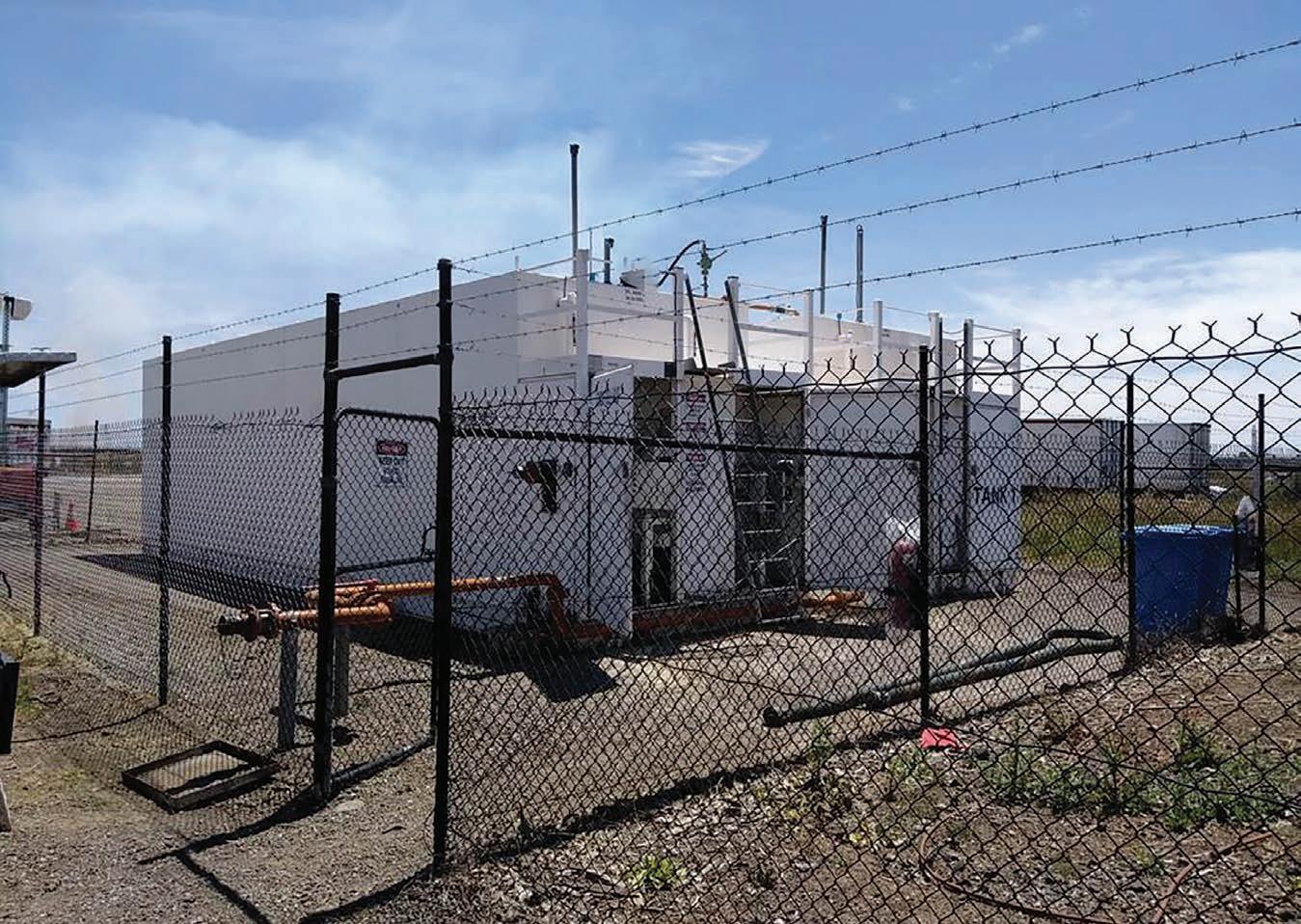

Automatic Tank Gauging (ATG) has also area, also creating more efficient systems for scheduling of fuel drops.”
ATG can be integrated into the FMS systems, allowing for easy monitoring with live data for scheduling, thus reducing inefficiencies across a whole system.
“The FMS and ATG systems have removed the manual recording of systems, creating far less mistakes. ATG systems can send an email alert when the system is low, supporting customers during busy times in which a lowlevel tank or a missed fuel order is not noted,” Schulz said.
“The email alert can also be sent to fuel suppliers to streamline the ordering process and keep sufficient fuel in the bulk storage tanks.”
Schulz said that Liquip Victoria will work with its customers through drawings, consultation and on site, where required, to understand their individual requirements.
“Depending on what they require, we will advise on a package that utilises as much standard equipment so that spares and servicing is simplified,” he said.
“We utilise off-the-shelf components where possible, as opposed to having to order in from overseas, to minimise long lead times in the event of a failure or a breakdown.”
For larger packages requiring multiple tanks, Schulz said Liquip Victoria will use its engineering department to design a 3-Dimensional model of the entire storage package, giving customers a clearer picture of how it will work logistically.
“We have our own in-house engineering team that can quickly adapt to meet the challenges of supplying a system or solution to suit the customers unique requirements,” he said.
Liquip Victoria has expanded its operations to service the diverse rail system operating across Australia. Whether it be in the harsh Australian outback or the inner city, managing director Jeff Borg said the company can tackle any challenge.
While supplying fuelling systems for a country the width and breadth of Australia can pose challenges, Borg said it is something the company takes in its stride.
“This distance produces challenges at times to get service completed in a timely fashion,” he said.
“The advantage of the Liquip Group is we have facilities in every state which allows us to better service the system nationally. Each Liquip group has its own service vehicles so we can attend service situations quickly or as scheduled by the customer.
“Having a national footprint provides continuity, a one stop shop and reduction in the number of companies the customer has to deal with at any given service interval. We usually have one central contact point who then manages which Liquip facility would be completing the service, pending the location.”
Liquip keeps important components for the rail industry, such as fuel nozzles, in stock at each location to ensure a fast turnaround for any work that may be needed.
“The team is trained in the different areas of the system to quickly expedite replacement parts, a solution or a service callout,” Schulz said. “The central single contact at Liquip makes the process of getting support easier and user friendly.”


ability to dial in remotely to review any issues or even provide training from off site to new team members.
Liquip Victoria comes under the banner of Liquip International, an organisation committed to continual growth and research in the fuelling space.
The company recognises that its core strategic asset is its ability to innovate and rapidly develop new solutions within a changing world. Its investment in research and development and its rapid response to customer requirements differentiates its product solutions.
Schulz said that the packages are designed and built to Australian standards utilising the best of Liquip International’s technology
The organisation understands the importance of a versatile system that can meet the needs of any challenge and the equipment represents that.
“We provide fuel storage packages to refuel local equipment with smaller nozzles to refuel smaller plant and vehicles,” Schulz said. “We are also providing pumping systems on tankers that refuel locomotives in remote locations or where an on-ground refuelling system is out of action.
“We service the tankers, calibrate them and ensure they meet the standards to ensure safe and efficient refuelling.
“Liquip Victoria is geared up to provide 24/7 support to customers fuel assets and provide a diverse range of equipment for any challenge at any location.”


GrainGrowers association wants to see more grain moved by rail across the country, it is important the industry makes sure it is prepared for any challenges this may create.
The movement of freight remains critically important for Australia’s farmers. GrainGrowers association has unveiled its National Grain Freight Strategy –a practical road map for government to help drive Australia’s global competitiveness.
GrainGrowers is a national organisation representing grain growers in Australia. Its members are farmers, and its goal is to represent growers in front of governments, industry leaders and other advocacy groups.
The strategy is designed to increase the productivity and efficiency of the supply chain, driving down costs and delivering savings for Australian growers.
Launching the strategy, GrainGrowers chair Rhys Turton said a unified and considered approach was vital to address a complex and multi-faceted issue.
“In the 2022-23 season, a record winter crop production of 65.7 million tonnes was moved from paddocks across regional
Australia, by either road or rail to port for export or to domestic markets,” he said. “The expense of moving grain is the single largest cost of production, with CSIRO modelling highlighting transport costs of $2.1 billion per annum.
“Increasingly, our ability to compete on the global stage is not just determined by what we grow, but also how efficiently and effectively we can get our grain to market. For context, prior to the conflict between Russia and Ukraine, both countries

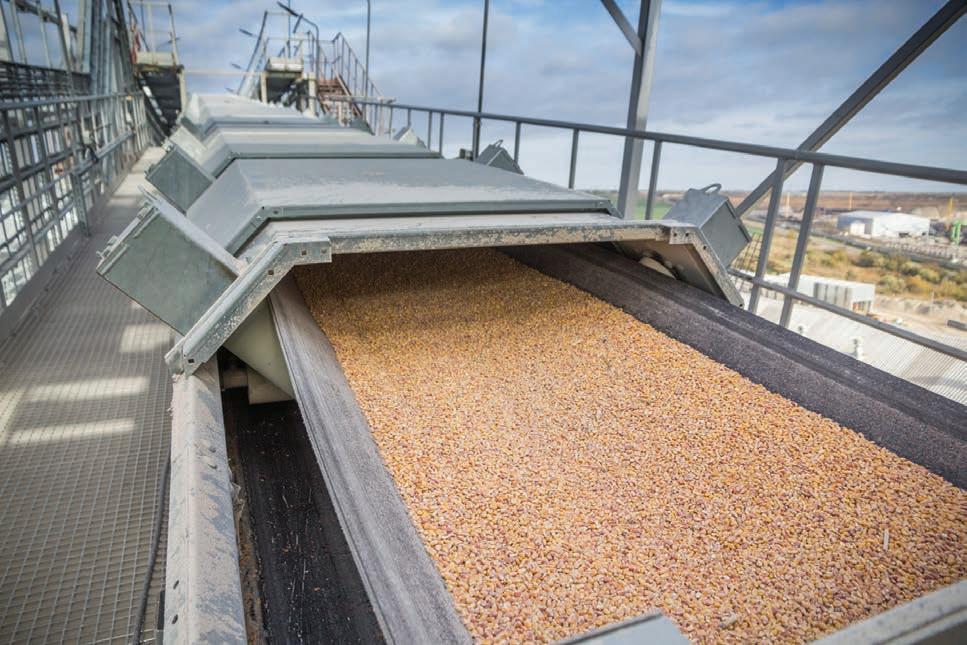
that impact transporting grain off farm such as local roads and bridges, it is vital the approach reflects the views of the broader supply chain.
“What we have now is a clear strategy built around six key objectives, with the potential to make a real difference to the productivity and efficiency of the grain freight supply chain.”
The grain industry is a vital pillar of the Australian economy, delivering an average of 45 million tonnes of grain annually over the past decade and contributing an average of $15.5 billion per annum in gross value to the Australian economy.
and livestock feedlots. According to CSIRO TranSIT modelling, transport costs the grain industry $2.1 billion per annum, representing the single largest cost in Australian grain production.
The past three record harvests have underscored capacity constraints within the network.
Despite having a proximity advantage to Indonesia, where sea transit times from Australia are 50-75 per cent less than transit times from Canadian and Ukrainian ports, Australia is experiencing heightened competition.
production costs were $70 to $120 AUD less than Australia’s.”
GrainGrowers commissioned international consulting firm LEK to develop the Connecting the Dots report to identify key pinch points in the supply chain. Following the report, GrainGrowers consulted with more than 40 stakeholders across the supply chain to gain further input into the issues.
“By collaborating with industry stakeholders and policymakers, we’re paving the way for a more efficient and resilient grain supply chain that meets the evolving needs of Australian grain growers,” Turton said. “While growers are at the heart of the strategy, with a key focus on the issues
However, high supply chain costs have a significant and direct impact on Australian grain growers and threaten the global competitiveness of the Australian grain industry.
Already facing comparatively higher costs of production, reducing supply chain costs presents a key opportunity to ensure Australian grain remains globally competitive and to deliver savings for Australian growers.
The Australian grain freight supply chain is characterised by diverse, complex and multidirectional freight journeys, often across multiple modes of transport.
From paddocks across regional Australia, grain travels either by road, rail or a combination of both, to port for export or to domestic markets such as flour and feed mills, malthouses, food manufacturers
While competitors Russia and Ukraine’s wheat exports are reduced at the present due to the conflict, export volumes are expected to normalise over the medium to long-term.
The report came to a number of conclusions to help better support the grain industry in Australia.
One was to encourage more competition and new supply chain entrants. The high cost of entry for key grain supply chain infrastructure such as rail, ports and stevedores, however, is often seen to restrict competition and deter new participants from entering the market.
The former Chair of the ACCC, Rod Sims noted the damage a bottleneck can cause.
“It is bad for the economy when bottleneck infrastructure, at the end of a crucial value chain, is in the hands of a company with unfettered market power,” he said.
GrainGrowers is concerned that the recent trend in privatising assets without adequate regulation is giving rise to monopolies that reduce efficiency, increase prices and damage the economy.
The organisation was concerned that when government privatises critical infrastructure such as ports, the process must not adversely impact competition and diminish Australia’s overall productivity and competitiveness.
GrainGrowers wants to see greater scalable capacity in the supply chain. As annual grain production fluctuates, the organisation believes scalability is important.
The past three successive record harvests highlight the limitations of the supply chain to export grain during key export windows. Exporting Australia’s grain as quickly as possible using least cost pathways following harvest is critical for capturing high international prices as Australia’s seasonal counter cyclicality presents an opportunity for Australian exporters to sell grain to international markets in times of reduced global supply.
As Australia’s national crop size continues to grow, to capitalise on higher prices, the industry’s supply chain must have sufficient capacity to handle the elevated volumes
of grains in a timely and cost-effective manner. Streamlining and harmonising regulation and reducing red tape is critical to unlocking productivity according to the report.
The report states that while Australia’s transport systems have evolved from separate state-based networks, they continue to suffer from a legacy of inconsistent systems and rules.
Grain rail transport operators must navigate significant administrative burden and complexities when travelling on a route that traverses multiple rail infrastructure manager networks.
These different systems and operations create significant additional complexity and cost, which are ultimately passed onto the rail users, as well as increasing safety risks due to human error from operating across different systems and networks with varying requirements.
Streamlining current inconsistent rules, while focusing on increasing productivity will increase compliance and lower administration costs for transport operators.
A resilient infrastructure network is critical for ensuring the efficient movement of grain to market.
Repeated flood events and persistent and unprecedented rainfall have deteriorated
critical road and rail infrastructure across Australia’s grain growing regions creating challenges for operators in delivering the critical commodity.
Road and rail infrastructure are long-lived investments, with roads typically having design lives of approximately 20 to 40 years. It is therefore crucial that investments are made now in building resilience to emerging issues associated with natural disasters and climate risk.
GrainGrowers want to see new technologies and innovation to support the supply chain moving forward. While the grain industry has significant legacy infrastructure, it is critical the industry continuously seeks to optimise the way things are done rather than replicate traditional modes of operation.
In addition to improving the efficiency of grain freight, new technologies can enhance safety on the road and rail network.
Autonomous freight vehicles (AFV) have the potential to significantly reduce freight costs, increase reliability and improve overall supply chain efficiency. These AFVs are nearing commercialisation, with some manufacturers predicting autonomous heavy vehicles will be on the roads as early as 2026.

The 2022-23 winter crop resulted in more than 65.7 million tonnes of grain being moved.
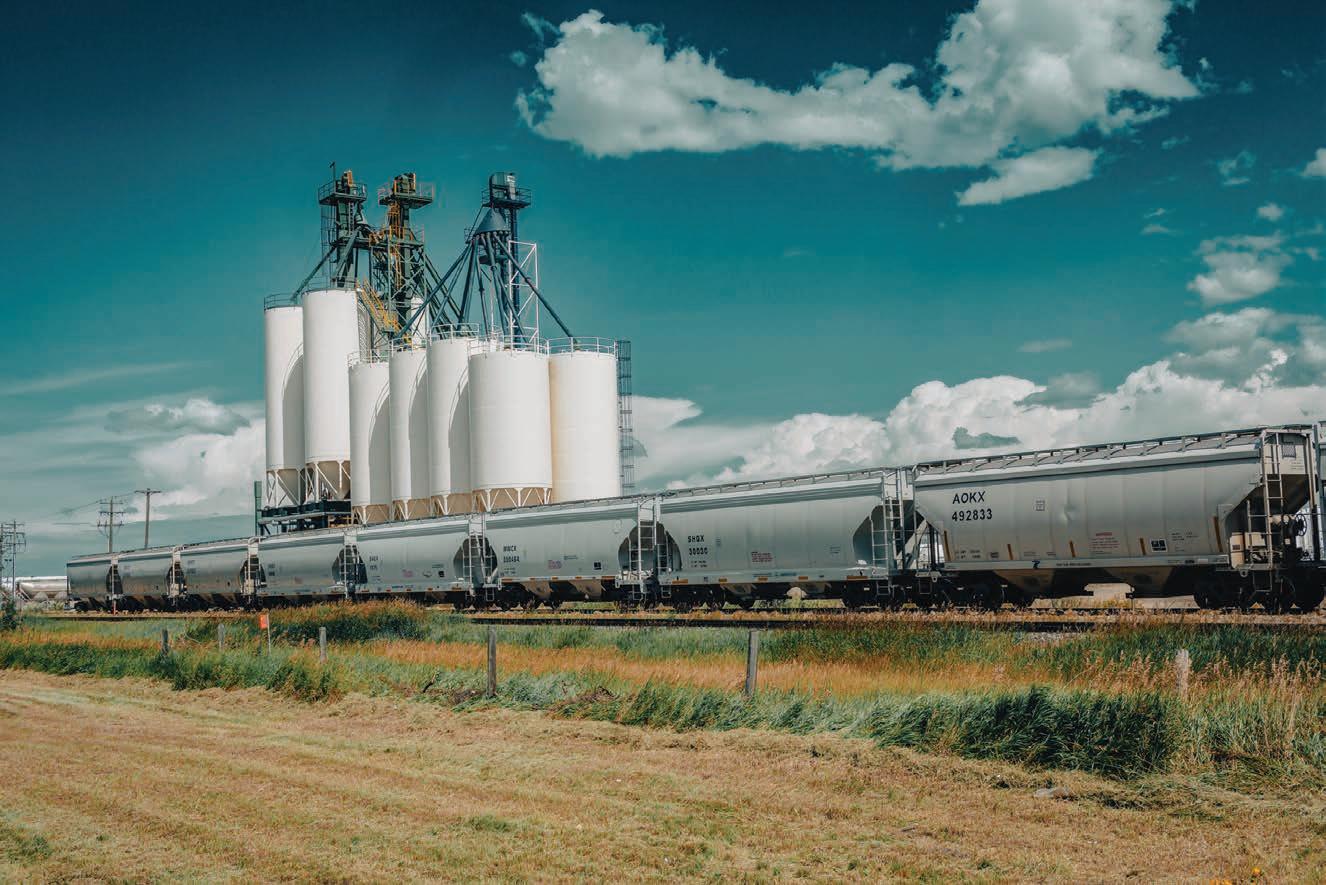
rail freight produces 16 times less carbon pollution than road freight per tonne kilometre travelled, valued at one cent per tonne kilometre.
ARA general manager of rail freight and heavy haul, Georgia Nicholls, said that the opportunity for rail to contribute more to the movement of grain around the country is massive.
“We need to see a much more efficient offering with timely and reliable services to meet the needs of grain growers,” she said.
“There are two main issues we have and that is the operating efficiency moving across various networks and the other is the resilience of the track to stand up to extreme weather events.
“We are very happy to see the commitment of funds to the rail network’s resilience across interstate networks and believe it will help more freight off roads and onto the rail network.”
As Nicholls explained, one of the key challenges facing rail freight is that Australia has highly localised rail networks with significant variations between states,
efficiency. This increases costs, which are ultimately borne by grain growers who receive a lower price for grain at the farm gate.
The National Grain Freight Strategy sets out short, medium and long-term priorities to ensure the continuing strength of the grain industry.
Provide targeted funding to upgrade the rail network within critical freight corridors.
Harmonisation of rolling stock access agreements across rail infrastructure managers and streamline approvals to facilitate adoption of new technologies.
Conduct an audit of existing infrastructure standards and identify opportunities for standardisation and network expansion.
Provide co-funding for industry to upgrade rail sidings and loading capacity to reduce train turnaround times.
Improve metropolitan rail network access for freight trains on shared freight and passenger lines.
Align train control and signalling technology on the eastern seaboard.
Formalise mandatory common standards for train components between jurisdictions.
Consolidate rail freight data held by government agencies and stakeholders into a single database.
Jurisdictions to identify priority grain freight routes for standardisation.
Harmonise safe working rules and systems.
Turton said GrainGrowers is proud to lead the charge in developing a comprehensive National Grain Freight Strategy.
“By collaborating with industry stakeholders and policymakers, we’re paving the way for a more efficient and resilient grain supply chain that meets the evolving needs of Australian grain growers,” he said.
“While growers are at the heart of the strategy, with a key focus on the issues that impact transporting grain off farm such as local roads and bridges, it is vital the approach reflects the views of the broader supply chain.”

A municipal works, civil and commercial construction event.
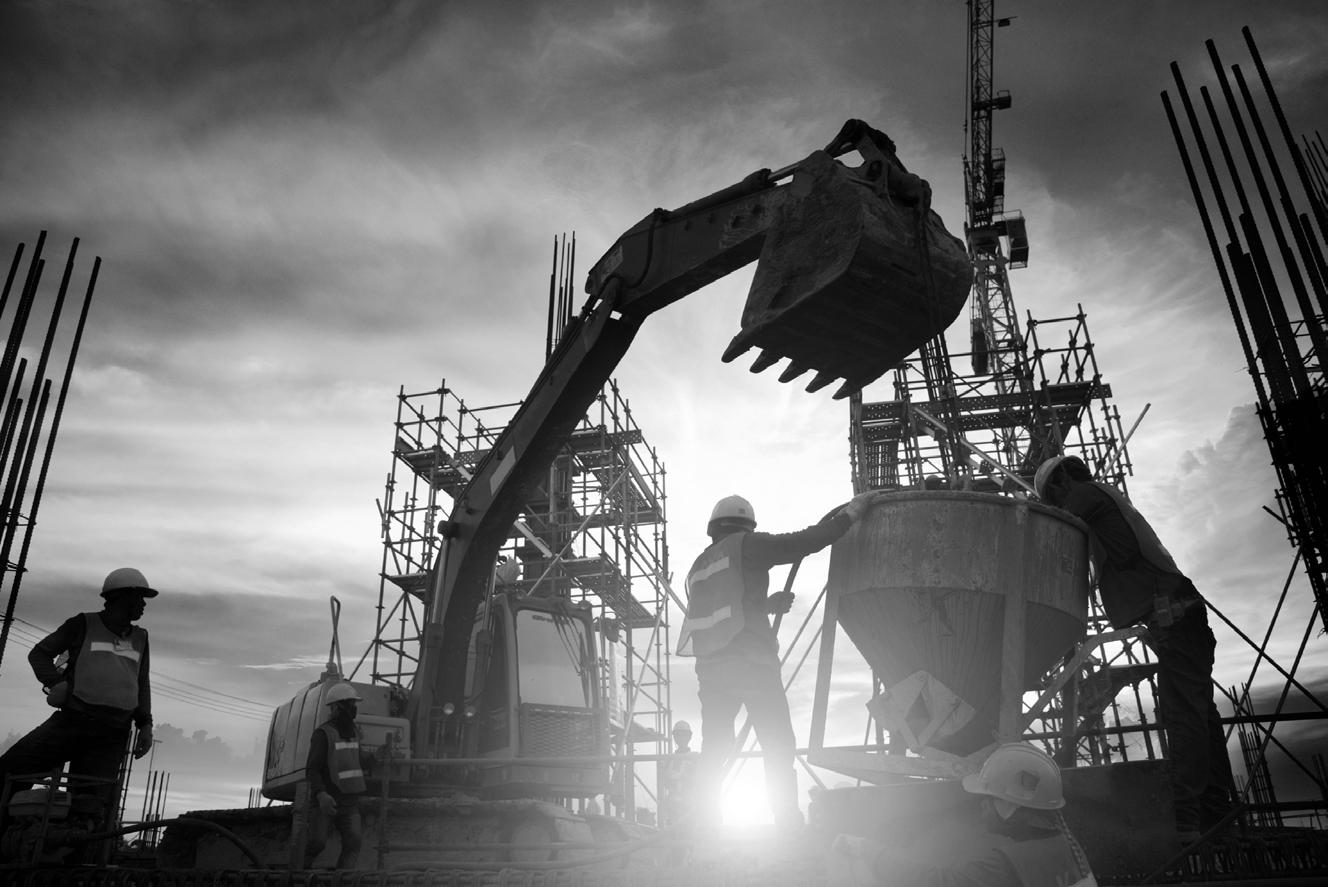
17-18 September 2025,
In September 2025, a new event will be landing at the Melbourne Convention and Exhibition Centre. Converge will bring together leading decision makers in the Municipal Works, Civil and Commercial Construction space, to share the tools, ideas and technologies that are shaping these sectors.
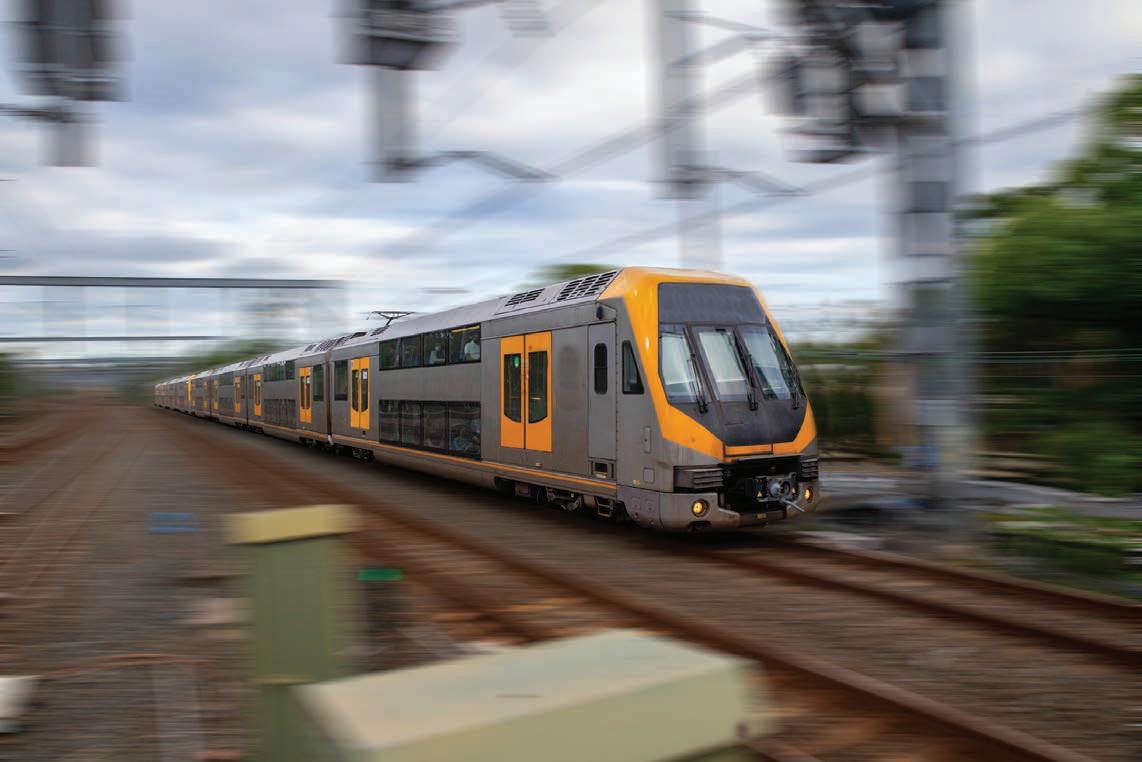
The plan follows the successful completion of the Rail Repair Plan that has resulted in fewer incidents and more reliable journeys.
Transport for New South Wales said the Rail Repair Plan, announced in June 2023, is ensuring passengers are now spending 35 per cent less time dealing with train delays related to infrastructure failures.
Sydney Trains engaged 2500 workers to fix 2116 defects, resurface 468 kilometres of track, replace 1163 train stop rams and remove 193 temporary speed restrictions.
Building on this successful model, the New South Wales Government is launching a $35 million Train Repair Plan that will upgrade more than 2000 cars, that make up 372 trains, in line with modern standards.
New South Wales Premier Chris Minns said it’s critical the government continues to focus on essential upgrades to minimise headaches for commuters on a rail network the size and complexity of New South Wales’.
“Incidents on the rail network are inevitable, but keeping our fleet in top shape is our key priority to reduce delays and cancellations,” he said. “The workers and apprentices on this project will be learning vital skills to not only maintain trains here in New South Wales, but to build our capacity to deliver the next generation of Tangaras.”
This 12-month plan is now underway and is the largest co-ordinated program of
28 per cent compared with the past financial year – resulting in 595 service cancellations and 2445 delays.
Using existing Sydney Trains budget and engaging workers in-house, the program includes improving technology, communications and operating systems, and critical repairs to doors, brakes, windows, air conditioning and CCTV cameras.
The Train Repair Plan has key targets to:
• remove 2037 train defects
• upgrade all 11 models of trains
• clear 306 train maintenance backlog repairs
• clean and paint 1622 train carriages
• accelerate 68 reliability projects, including toilet upgrades, air conditioning, engine replacements, technology system upgrades, brakes, doors and windows
• complete life extension works for diesel fleets including the XPT, Endeavour and Xplorer
Sydney Trains Chief Executive Matt Longland explained the importance of the work.
“With some of our train fleet over 50 years old, passengers are feeling the brunt of our ageing assets,” he said.
“Sydney Trains is working hard to ensure the impact on passengers is minimised during this work, which will see some minor
recommendation from the Rail Infrastructure and Systems Review, which found fleet performance was well below targets for availability and reliability.
The program is distinct from the $447 million Tangara life extension work announced in the 2024-25 State Budget, which will ensure that this iconic fleet remains fit for service as the government forges ahead with building the next generation of Tangaras.
The fleet maintenance work will be complemented by the introduction of the Mariyung fleet, which is on track to be delivered by the end of 2024, enabling 50-year-old V Sets to progressively retire.
Minister for Transport Jo Haylen said the Rail Repair Plan was a success in bringing the trackwork backlog under control and giving passengers smoother journeys and it was logical the government apply that same strategy to its train fleet.
“Fleet defects are a significant driver of delays. We need to make sure our existing trains are healthy, strong and reliable, which is why we’re accelerating two years of work into the next 12 months,” she said.
“Around 800 Sydney Trains staff will be working around the clock – 24 hours, 7 days a week – on the Train Repair Plan and I want to thank every one of them for undertaking this massive job.”

Tony Coen was recently awarded an Order of Australia Medal for his services to Tasmania’s rail network. He has grand ideas for the future of the network.
Even after being awarded an Order of Australia Medal (OAM), Tony Coen is not resting on his laurels. He stepped away from writing a letter to the Tasmanian Government calling for better support for heritage rail in the state, to speak with Rail Express about his recent honour and his work in rail.
Coen received an OAM for services to railway preservation and to pipe band music. He has a long history with the rail industry, starting as a fireman and then progressing to driver with the Tasmanian Government Railways and transitioning to a number of heritage railway organisations.
This includes Association of Tourist and Heritage Rail Australia, Tasmanian Transport
Museum, Derwent Valley Railway, Don River Railway and Tasmania Association of Tourist Railways. Coen explained however, that his journey to trains was a little different to the norm.
“My father used to encourage me to take an interest in anything steam powered,” he said.
“As a boy I’d travel from Hobart and Bellerive on the ferries to go to school and they were steam powered. You could find me hanging around the engine room. I used to get to know the engineers over the years.
“I grew up in the twilight age of steam and so I became keen on the railways.”
Coen joined the Tasmanian Government Railway in 1966 as a trainee engineman
and then soon qualified as fireman, thus beginning a long relationship between Tasmania’s rail network and himself. He was a fireman for eight and a half years before moving onto the role of driver.
But perhaps Coen’s true service to Tasmania’s rail network was the preservation of the state’s rail assets. He first became involved in the preservation with his good friend Dr David Flecker when the pair put in a tender for a steam locomotive and won.
“We then began the company [Tasmania Locomotive Company], raising funds and began running excursion trains,” Coen said.
“Our depot was in the Cadbury chocolate yard. Cadbury were very good to us. We ran onto the main line from the Cadbury yard.”
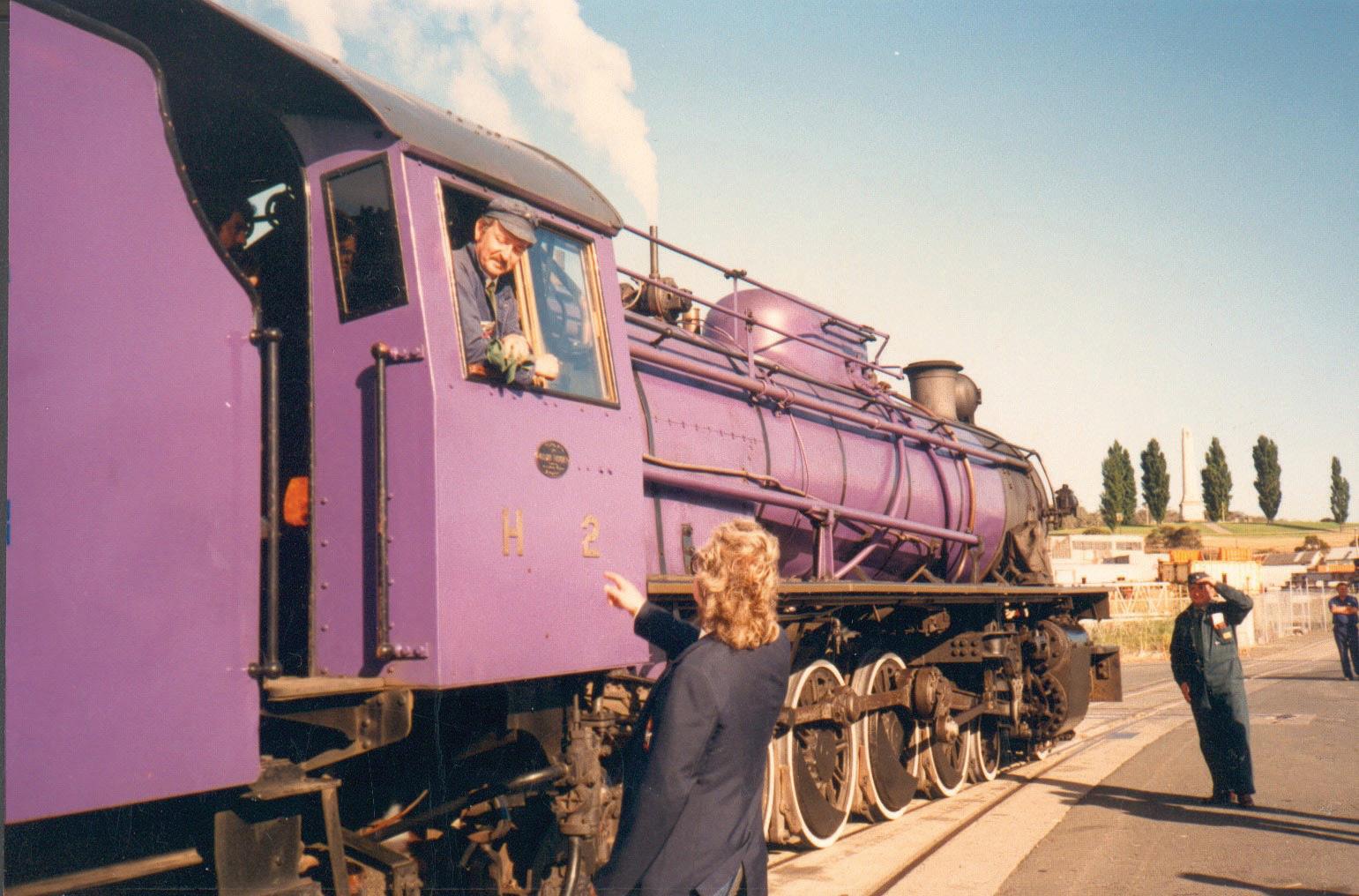
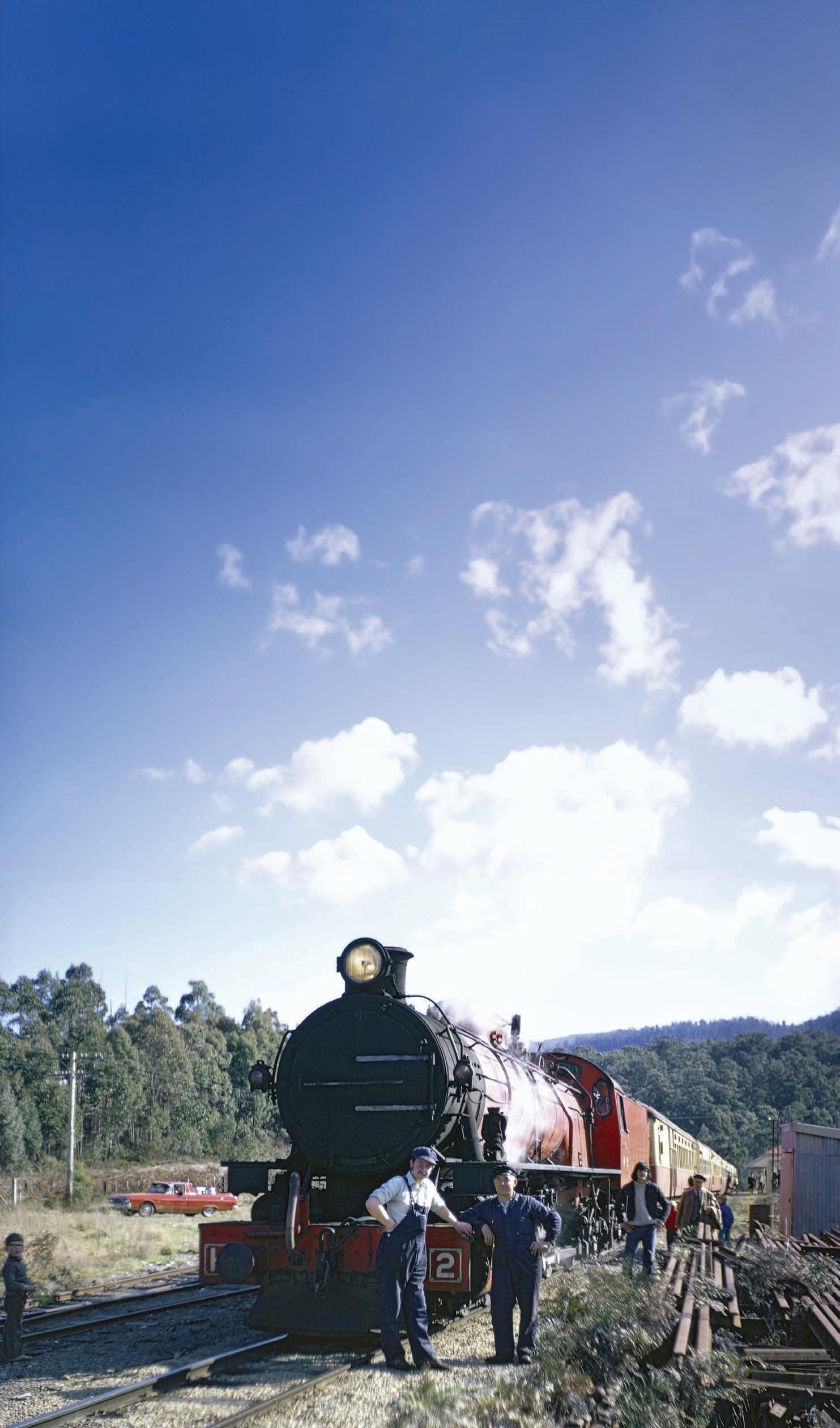


Coen said that rail preservation has struggled in Tasmania when compared to other states and he has been continually advocating for the industry in the state.
“We have managed to get things slightly restored but we are still not running on the main lines,” he said. “The organisation [Tasmanian Association of Tourist Railways] has been working with the state government to get sensible insurance cover.
“The government recently came to the table and supported us with this.”
Coen joined the Tasmanian Transport Museum in 1963 as a schoolboy. He explained that a group of school-aged boys bought one of the last trams from Hobart and that is how his association with heritage rail started.
“They pooled their money and somehow they could afford it,” Coen chuckled.
“I am not sure how they got it from the depot across to the waterfront, but they must have moved it there by a lorry and thus began the organisation.
“I joined soon after that and my mother paid my membership for me.”
That tram entered the Transport Museum and remains there until this day, having been lovingly cared for.
Coen’s passion began with a love of all things steam, including trains and ships, but it has grown to include all things rail.
“To me it doesn’t matter what is pulling it, seeing trains doing work and pulling things is always impressive.”
Tony Coen
“To me it doesn’t matter what is pulling it, seeing trains doing work and pulling things is always impressive,” he said.
“It was steam trains originally but traction engines were also interesting to me.”
Coen’s time working on trains saw him spend most of his time working as a fireman and he said that it was sometimes hard work.
“They [steam trains] weren’t pleasant things at times,” he said.
“Firing engines could be bloody hard work and it was not just shovelling coal, it was working with the clinker in the firebox and helping to build up the steam.
“The thing was though, the machine would talk to you, they were alive. You don’t get that with a diesel train and that is what makes steam engines special.”
It’s obvious steam trains still hold a special place for Coen. He reminisces about the openness of the cabin and the beauty of a hard-working steam train.
“When you were leading with the tender in bad weather you would just have everything flying over the back, bouncing off the coal and straight into you,” he said. “You would be wet and cold on one side with black spots all over you and then your back would be hot and dry thanks to the fire.
“Last week we had trains down here running during the cold snap. It didn’t get over 11 degrees and because it was so cold the steam would settle. It created some beautiful visuals for those in attendance.”
The Australian Football League recently announced that Tasmania would receive the league’s 19th licence. It was also announced a new stadium would be built at Macquarie Point in Hobart. However there’s a building standing in its way and Coen wants to fight for it.
A 109-year-old rail goods shed runs through the centre of the proposed

“The building is in good shape, which will make it a difficult job to move. It is big and it will take a lot of work to size it up, dismantle it and put it back together.
“They want to move it across to the other side of the stadium and put it at right angles.”
The goods shed is still used to this day. The organisation is proposing to use it as a tourist and heritage railway station and as an intrastate coach terminal for the state’s existing bus network.
“It is big enough to be used as an exhibition space, which it already is used for now,” Coen said.
“Our proposal is to have railway access so we can continue running our heritage trains. We could even see it being turned into a railway station in the future and it might be able to service the stadium if Tasmania’s train network grows.”
Coen’s passion for rail does not just start and end at the heritage rail network but extends to the future of the state’s rail network.
The Tasmanian rail network is a singleline, narrow gauge transport system.
The operational network extends from Brighton to Western Junction and to the
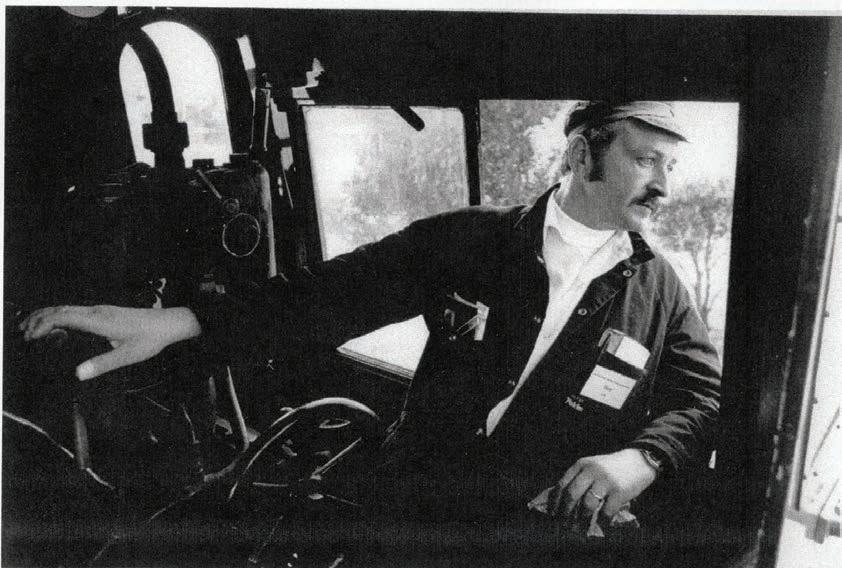
provided to Fingal in the east and Boyer in the Derwent Valley.
The Melba Line (formerly named the Emu Bay Line) connects the West Coast to Burnie and is currently operated by TasRail.
Currently the state has no passenger network and Coen wants to see this change.
“I think Tasmania needs suburban trains once again,” he said. “I know it takes a long time to travel by train in Tasmania because of the mountains between Hobart and the Midlands, but with modern trains it is far more achievable than it was in the past.
interest soon.” Coen believes the return of the commuter rail network will help further prop up the freight network to take the strain off the state’s road network.
“If we can get freight off our roads and onto rail we can save billions in government spending on our roads,” he said.
“I think it will be important that we do not have a monopoly, so the load is being shared across a range of transport options, but we can better utilise rail networks in the state.”





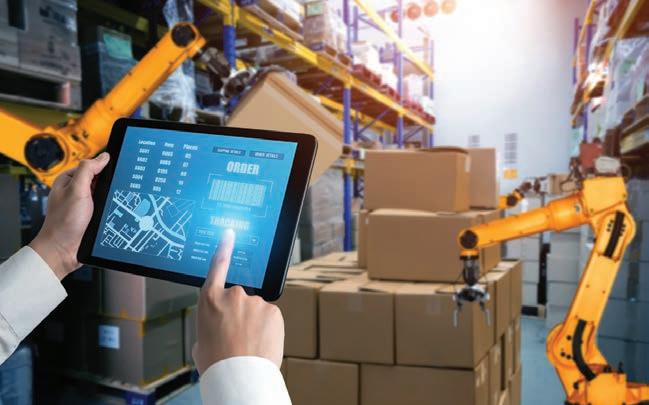

For the first time since 2018, visitors to the iconic Puffing Billy Railway can once again enjoy the century-old tradition of sitting on the sills of an openside carriage for the full length of the railway journey.

Victorian Minister for Tourism, Sport and Major Events Steve Dimopoulos joined Tim North OAM, Member of the King’s Counsel and chair of the Puffing Billy Railway Board, at the railway’s Lakeside Visitor Centre in Emerald to announce the return of the full iconic experience after a six-year hiatus.
More than 400,000 local and international visitors climb aboard the railway to enjoy the preserved heritage steam train every year.
The return of leg dangling from Belgrave to Gembrook, one hour from Melbourne, has been made possible by the Victorian Government’s $1.4 million upgrade to both the Gembrook Historic Station and Menzies Creek Station.
The project has restored the Gembrook station’s facade back to its original glory –celebrating its rich heritage dating back to the town’s initial settlement in 1873.
“Puffing Billy has been one of the most beloved experiences for Victorians and international visitors for more than 100 years, and now visitors can enjoy the excitement of sitting on the sills for the full length of the journey,” Dimopoulos said.
These works follow the 2021 opening of the Lakeside Visitor Centre, backed by a
Architecture Awards in Chicago.
The Lakeside Visitor Centre is the centrepiece of the Puffing Billy Railway, celebrating the history of the centuryold heritage railway through a collection of steam-era artifacts and an immersive multimedia experience.
Puffing Billy Railway has been part of Victoria’s railway history for 123 years, with generations of families making the journey through the Dandenong Ranges at the muchloved attraction.
Built in 1900 to serve the local communities that lived in the hills, the train carried not only passengers, but mail, parcels, newspapers, perishables, home supplies, farm requisites, livestock and general goods away from Melbourne.
The distinctive whistle that travels throughout the hills will soon be heard once more as the train winds its way through towering forest, around bends and over timber trestle bridges, while children onboard wave at passers-by, made possible by the
section of Puffing Billy Railway. This beloved tradition is back, allowing our passengers to experience the full charm of the Puffing Billy journey,” North said.
The railway is now preparing for its annual Puffing Billy Running Festival, scheduled for two days across September.
The festival will host a new 1.2-kilometre kids dash a, 5-kilometre family fun run/walk, a 13.5-kilometre classic run plus an all-new 21.1-kilometre road and trail half marathon, all held with echoing toots and puffs of Puffing Billy in the background.
Member for Monbulk Daniela De Martino, highlighted the economic importance of the heritage railway.
“We are proud to continue supporting Puffing Billy which provides many jobs and greatly contributes to the local economy across the Dandenong Ranges and Yarra Valley,” she said.
Learn more about Puffing Billy and the Puffing Billy Running Festival by visiting the Puffing Billy Railway website.






Wellness in Infrastructure is looking to better support mental health across the sector.
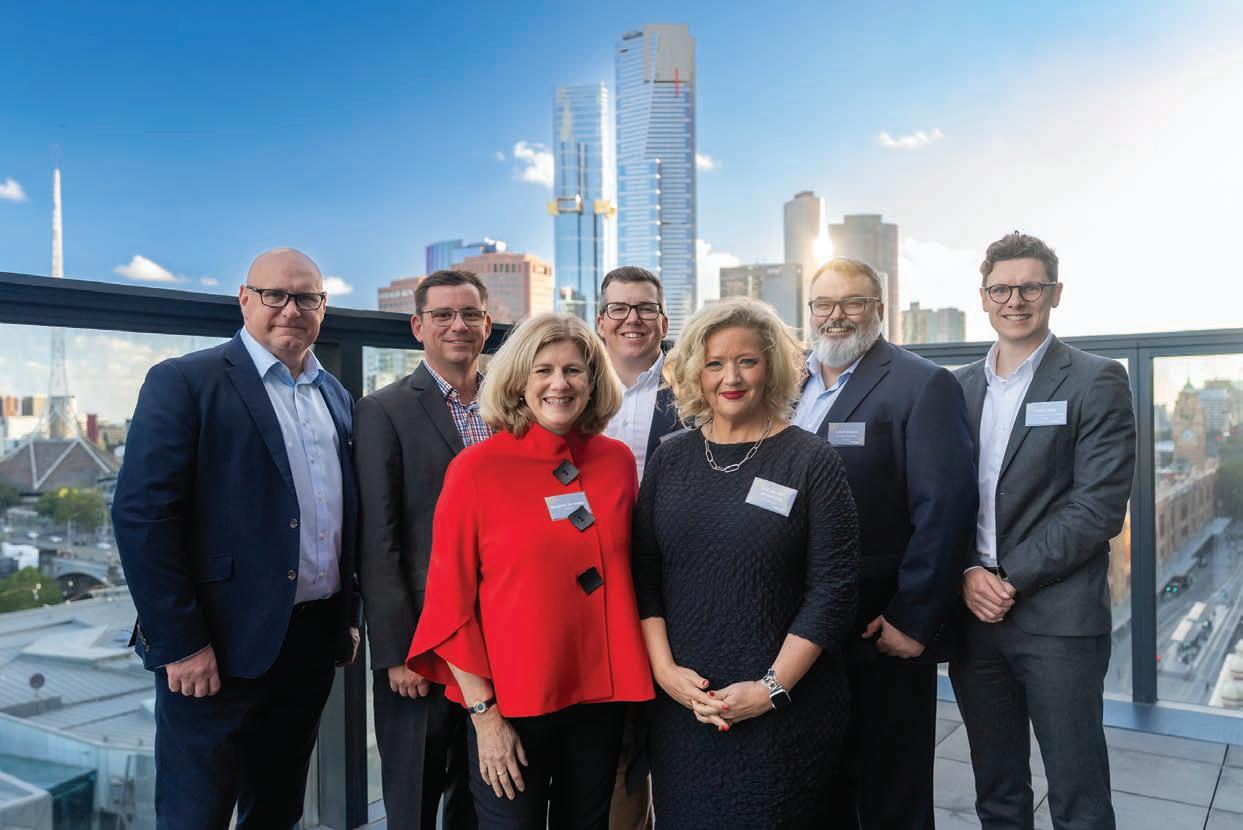
being encountered by professionals in the infrastructure construction industry developed the Wellness in Infrastructure (WII) initiative.
Professor Luke Downey from Swinburne University inspired the initiative with a study he conducted. This study incorporated feedback and insights from those in the sector and revealed that nearly half of the 683 infrastructure industry respondents suffered from burnout, while 85 per cent reported moderate to high levels of stress.
Various Tier One and Tier Two infrastructure construction companies formed WII through the collaboration of volunteers from each organisation, along with those from Victorian Government authorities and industry associations.
From its onset, the initiative aimed to address the prevalent issue of poor mental health among infrastructure industry staff and the known industry factors contributing
committee comprised of senior business leaders within the industry. This committee was supported by a working group of industry participants who were passionate about uniting and exchanging ideas on best practices.
The steering committee worked towards driving high-level change in infrastructure construction companies as a collective.
Since its formation, WII has achieved several milestones in its drive to improve mental health and wellness in the infrastructure construction industry.
WII conducted an Industry Survey and Report – at the time it was the largest mental health and wellness survey in the construction sector –highlighting what it labelled the unsustainable levels of compromised health and wellness from the respondents. The report surveyed a cross-section of more than 100 employees
current state of mental health in the industry.
Another key milestone was the establishment of the Integrated Approach to Wellness Program. This work demonstrated what is possible when taking a preventative approach to mental health and wellbeing. This program has continued to be implemented across several projects and programs of work after its successful piloting on the Mordialloc Freeway Project.
The Program was well supported by WorkSafe WorkWell Mental Health Improvement Fund. The integrated approach was also an award finalist at the 2024 Civil Construction Industry People and Training Awards.
A key pillar of success for WII was the establishment of the WII mentoring program. It provided a platform for passionate industry mentors and mentees to enhance their skills, contributing to the transformation of the
industry and improving the management of mental health issues in the present and future.
WII, in collaboration with Professor Downey, undertook a five-year follow-up in late 2023, which resulted in more than 1411 survey responses from the industry. The results reveal that workers in the infrastructure industry remain at some of the highest risk in society for burnout, declining mental health, stress, and dissatisfaction with work-life balance despite several improvements in the results of the last survey conducted in 2018.
The infrastructure and construction industry continues to face challenges in terms of the mental health and wellbeing of its professionals.
WII believes these challenges are having a negative impact on the industry’s productivity, diversity, and overall attractiveness. Therefore, it is crucial to address the physical and psychological risks that industry professionals encounter and improve their overall health and wellbeing.
WII provides verified interventions, support, and resources to safer, healthier work environments that benefit employees and employers alike.
WII has a track record of developing and providing effective programs and tools that have been validated to improve mental health, wellbeing, and productivity.
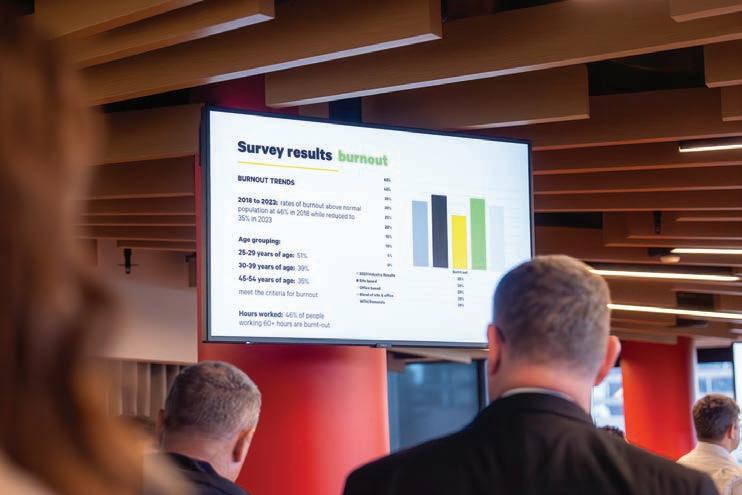
WII has demonstrated a commitment to improving the industry, and its interventions have proven effective in improving mental health and business outcomes.
Today, WII is formally established as a not-for-profit, health- promoting charitable organisation and comprises a board of experienced individuals and more than 40 volunteers from across the industry. All are working towards a single goal, which is to achieve world-class mental health and wellness within the industry across Australia.
WII has reached a definitive point in its
Upfront contributions to WII will help to employ key personnel to promote, administer, and expand the organisation as well as develop mental health framework tools and interventions designed specifically for the infrastructure/construction industry and to share best practice initiatives from across the industry.
WII, along with its partners and supporters from across the sector, is aiming to create an industry that is more productive, rewarding, and sustainable for professionals of today and tomorrow. This is

A new event is set to assist Australia with major projects, bringing together a range of industry experts to showcase the latest tools and technology in the municipal works, civil and commercial construction space.
Converge is a brand-new expo that for the first time will bring together municipal works, as well as commercial and civil construction to provide attendees a glimpse at Australia’s infrastructure future.
Australia is in the midst of a range of infrastructure projects changing the fabric of its rail systems. From level crossing removals through to major projects such as Cross River Rail and the Suburban Rail Loop, now is the time for the infrastructure sector to hone its skills and collaborate.
Set to be held in September 2025, Converge will be the one-stop-shop for sub-contractors, project engineers, council fleet managers, and large-scale construction contractors focused across the municipal works, civil construction and infrastructure space.
Lauren Chartres, Converge show director said the event will cover everything that’s required to successfully deliver infrastructure works, including equipment right through to planning and management software.
“Unlike other events, Converge covers the entire infrastructure sector and will showcase equipment and demonstrations right on the expo floor,” she said.
“It’s the perfect opportunity for businesses that have clients from Tier One and Two contractors right through to smaller operators and council departments to connect with those companies in one place, at one time. We know that nothing like Converge currently exists within Australia.”
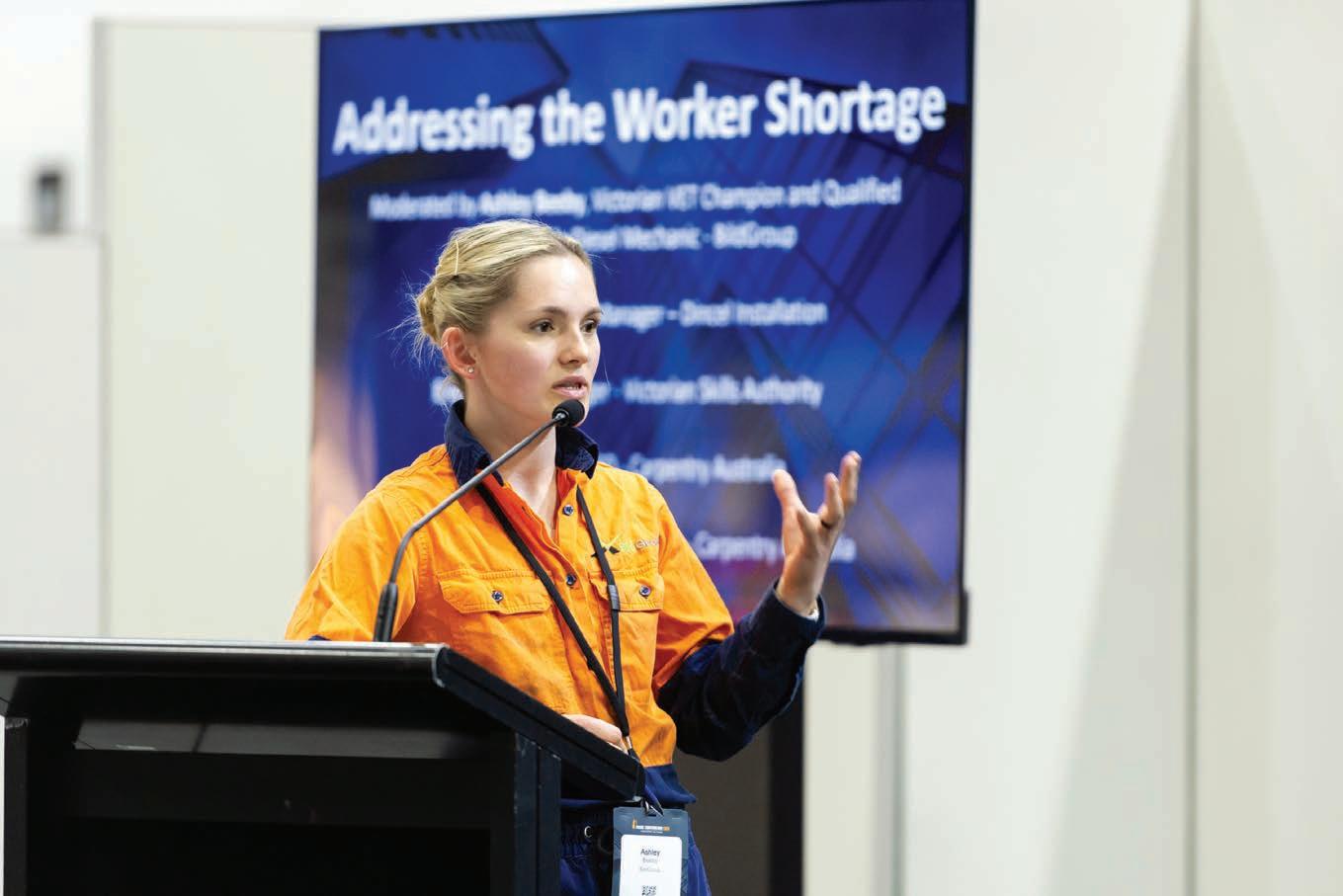
Sarah Bachmann, Chief Executive Officer – National Precast Concrete Association Australia, said the event will likely present an ideal opportunity for the precast sector to connect with other areas of the market.
“At Converge, civil and infrastructure precast manufacturers can benefit from interactive networking sessions as well as attending and presenting at educational sessions on changes to sustainability requirements, the trend towards offsite construction, regulatory updates, design solutions, quality control and case studies.
Australia face challenges including adapting to evolving regulations, meeting sustainability demands, managing supply chain disruptions and addressing skilled labour shortages.
“Technological integration and market competition also pose issues, along with project-specific requirements and economic fluctuations. Overcoming these concerns requires staying current with industry trends, investing in technology and developing strong stakeholder relationships.”
adequate infrastructure can meet demand for decades to come.
From the construction site to the boardroom, Converge will be the new home for important discussions and knowledge exchanges around the development of essential infrastructure projects, big and small. This and much more will involve a wide intersection of stakeholders across every step of the building process.
Co-located with No-Dig Down Under, Converge will take advantage of an active audience of engineers involved in

infrastructure construction and management, who attend the event as a part of their Continual Professional Development through Engineers Australia.
A major segment of Converge will be dedicated to civil construction. This area will offer Tier One through to Tier Three contractors a view of the latest equipment and technology available on the market.
The dedicated construction technology space will include a stage featuring live demonstrations of the latest software available that is transforming commercial construction projects.
A dedicated conference area will also welcome leaders from major civil works projects to share knowledge on Victoria’s Big Build projects, as well as the 10-year, $120 billion infrastructure pipeline for the state, offering unprecedented access to decision makers in this space.
“We want to ensure that we’re providing the opportunity for thought leadership and provoking conversations about the future of the Australian infrastructure sector,” Chartres said.
“Converge will feature an Inside Construction summit, focused on project
updates from Tier One construction companies. The summit is designed to connect C-suite leaders with other project managers and those responsible for largescale projects, so that we can benefit from shared learnings and experiences.”
A niche area for councils and asset managers to see the latest tools available in municipal works will also feature.
From horticulture equipment through to road maintenance, and larger-scale trade equipment, the area will act as a onestop-shop for council fleet managers and sub-contractors to see the latest tools on offer, with a special focus on zero emission technology.
Peter Ali, Chief Executive Officer –Municipal Works Australia, said Converge will give councils and local municipalities a chance to see what’s in store for the future.
“Our local government officials operate in a rapidly expanding field. Converge will give them access to products they may not know exist and offer solutions to the issues they face daily,” he said.
“Converge closely aligns with our core purpose, which is to provide opportunities for people working in municipal works to learn about the latest innovations in municipal practices and expand their professional network.
“The event’s scale looks impressive, and it will be great to see numerous people sharing a common interest in civil infrastructure all in one place.”
Converge attendees and exhibitors will also be able to benefit from extensive media coverage in the lead-up, during and after the event, with exposure to an accumulated audience of decision makers of more than one million people.
Rail Express will be joined by Roads & Infrastructure and Infrastructure magazines and other renowned titles including Earthmovers & Excavators, Earthmoving Equipment, Utility Magazine, Inside Construction, Council Magazine and Tradie Magazine. Whether you’re an engineer, asset manager, project or procurement manager, or even a sub-contractor, Converge is the event for you.
Converge will take place on September 17-18 2025 at the Melbourne Convention and Exhibition Centre.

Early-bird opportunities are now available for exhibitors, with more information on exhibiting and much more available at convergeexpo.com.au
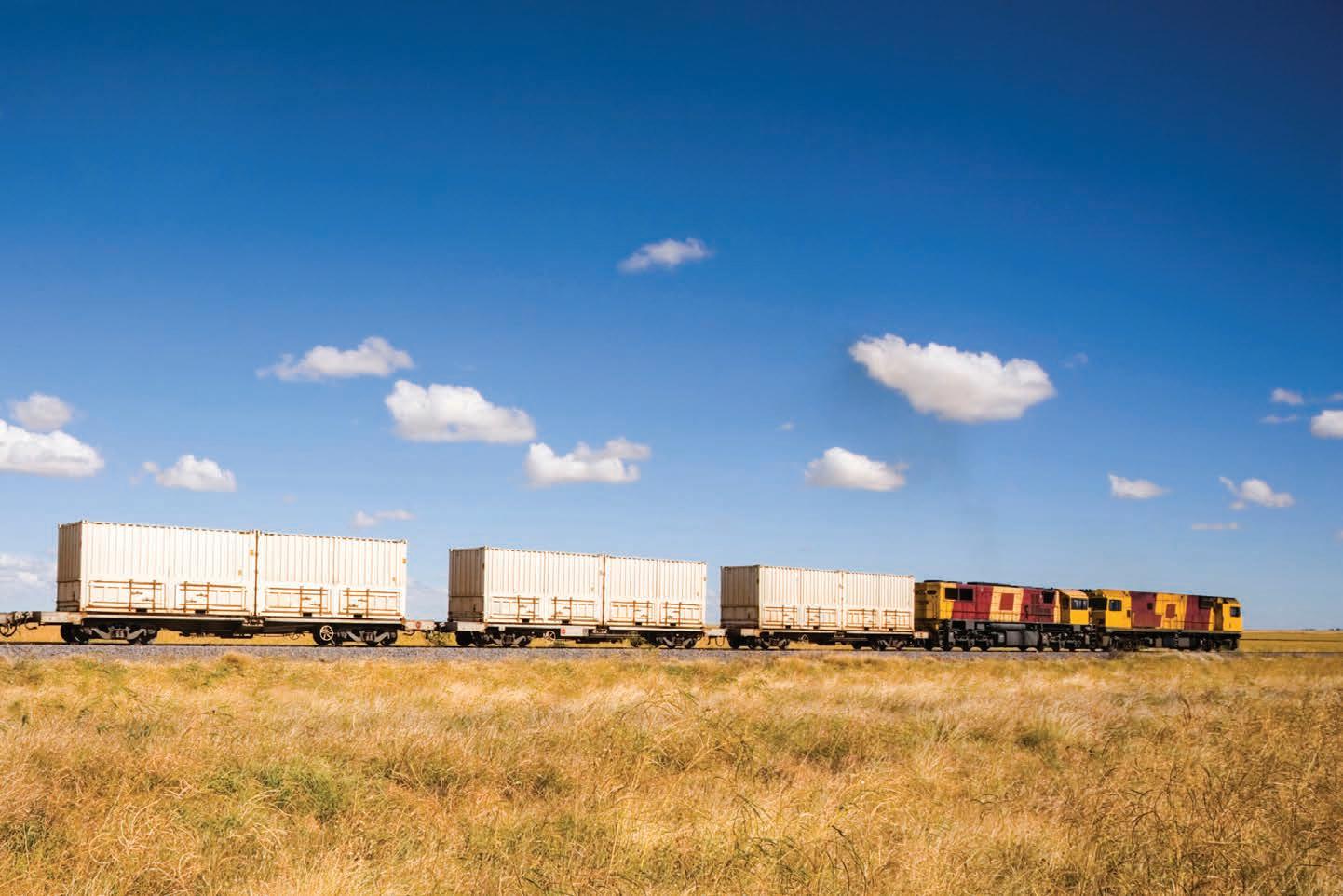
Queensland is seeking to better support its minerals sector by improving its freight corridor.
Queensland’s ability to freight critical minerals on the Mount Isa rail line will be investigated to help optimise delivery and support North Queensland’s regional communities and the critical minerals sector.
The Minister for Transport and Main Roads, Bart Mellish, said the investigation will explore how to improve rail freight volumes on the Mount Isa rail line through targeted consultation.
In addition to maximising the use of the Mount Isa rail line, the State Government has committed $2 million in the Queensland Transport and Roads Investment Program 2024-25 to 2027-28 to re-examine the feasibility of the Townsville Eastern Access Rail Corridor project.
A previous business case for the 8.3-kilometre rail freight corridor connecting the North Coast Line directly to the Port of Townsville was completed in 2017. It will be refreshed to examine the economic feasibility of the project based on current freight demand.
Mellish said Queensland has an enormous opportunity to export important critical minerals to the world. The Mount Isa rail line freight corridor is key to supporting the sector to access those markets.
“We will work with industry stakeholders to inform the possible approaches to support industry in increasing freight transport on the Mount Isa rail line. Moving freight from road to rail offers additional flow-on benefits
in terms of road safety, road infrastructure management and reducing carbon emissions from reduced heavy vehicle usage,” he said.
There is an opportunity for Queensland to capitalise on the global demand for critical minerals and fully unlock the estimated $500 billion of critical minerals in the Northwest Minerals Province, according to Mellish.
“Freight transportation is an important and key consideration in realising the growth of Queensland’s critical minerals sector and associated benefits, such as battery technology in support of decarbonisation efforts.”
The department will also seek feedback about the challenges and limitations to using rail for small and medium-sized critical mineral producers.
Townsville Enterprise Chief Executive Officer, Claudia Brumme-Smith said the proposed Townsville Eastern Access Rail Corridor (TEARC), which will connect the North Coast rail line to the Port of Townsville, has long been identified as the critical piece of infrastructure needed to improve rail access into the Port of Townsville and support a more efficient rail infrastructure layout.
“TEARC will not only support the growth of industries like mining and critical minerals but will also strengthen the region’s economic resilience by streamlining logistics and ensuring cost competitive access to global markets,” she said. “TEARC will remove significant rail freight movements
out of the Townsville CBD, providing further opportunities to enhance Townsville’s liveability appeal.
“We thank the Queensland Government’s commitment to revisit the TEARC business case.”
Optimising freight transport on the Mount Isa rail line may also support North Queensland regional communities by helping to reduce freight transport-related costs while providing long-term commercial certainty for industry when determining transport solutions.
The Northwest Minerals Province is one of the world’s richest mineral producing areas containing copper, lead and zinc, as well as major silver and phosphate deposits and strong rare earth potential.
The consultation outcomes will help government to consider the best approach for the Mount Isa rail line to encourage freight modal shift from road to rail, and support growth in rail freight volumes.
Modal shift from road to rail also offers some potential additional flow-on benefits in terms of road safety, road infrastructure management and reducing carbon emissions from reduced heavy vehicle usage.
The Mount Isa rail line spans more than 1000 kilometres, and plays an important role in supporting regional communities, regional jobs and mineral freight exports in North Queensland.


Alternative fuels are becoming more and more popular as the rail industry aims to bridge the gap between existing fuels and future electric machinery.

Australia is in the midst of a rail infrastructure boom and across every state it is imperative sites operate as sustainably as possible.
With net-zero targets on the horizon, many projects are finding innovative ways to lower carbon emissions, among them is a METRONET project in Western Australia trying some exciting new fuels in its plant and equipment.
In what is a first for Western Australia’s construction industry, the METRONET Byford Rail Extension is trialling the use of renewable diesel to help reduce its carbon footprint.
Known as Hydrotreated Vegetable Oil (HVO), the renewable diesel is made from fats, vegetable oils and waste products from the food industry and restaurants. It’s replacing regular diesel typically used to run four pieces of onsite plant and equipment.
HVO is known as a ‘drop in fuel’, which is widely available in other countries at price parity. It is therefore a transitional solution to reducing Scope 1 emissions in the construction industry.
This makes it a reliable solution for the existing fleet while electric machinery is
implemented and associated wide-scale changes are made. METRONET Sustainability Lead Alita Hancock explained the importance of the project.
“The project will substitute 23,000 litres of traditional diesel with HVO, which is expected to produce 95 per cent fewer carbon dioxide emissions and less noxious gases, all while delivering the same performance as regular diesel,” she said.
“Reducing emissions of heavy vehicles, rail freight, mining, agriculture, construction plant and equipment can be challenging. Trials such as this aim to demonstrate the role renewable fuels can play in helping to achieve sustainability targets.”
A METRONET spokesperson further explained that the use of HVO fuel is critical to achieving net zero and will bridge the gap in the construction industry as sites transition to electric heavy machinery.
“The trial on the METRONET Byford Rail Extension will reduce the carbon footprint onsite, working towards creating a sustainable legacy for Perth through the various stages of infrastructure delivery,” the spokesperson said.
“Although still in the early stages of the trial, there has been positive feedback on the output of performance of machinery, showing that HVO is a dynamic and interchangeable fuel source.
“This trial will not only fuel awareness of initiatives to reduce overall emissions throughout construction, but it also aims to encourage local demand and supply in hopes that industry-wide use is implemented in the future.”
The HVO trial is being run in partnership with Curtin University. Researchers will carry out studies to understand implications for fuel efficiency, emission reduction and impacts to engines.
The data captured will be provided to the Department of Transport to show the viability of HVO fuel for current and future infrastructure projects, and to help build the case for wider industry use once Western Australia’s supply of HVO is available in 2025-26.
This initiative aligns with the METRONET Sustainability Strategy to identify and implement practical ways to reduce the carbon footprint of METRONET projects.

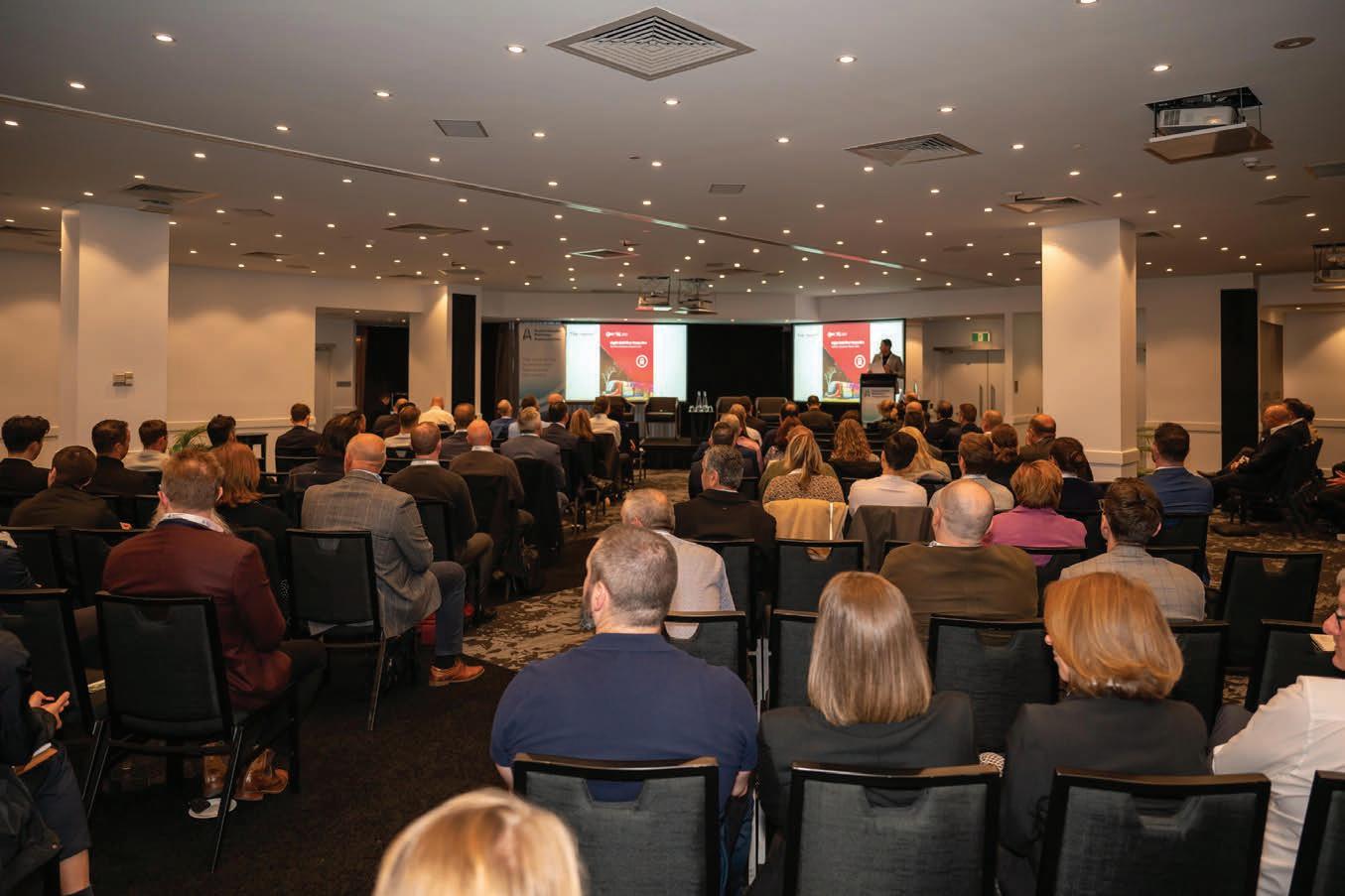
The Australasian Railway Association held its Light Rail Conference celebrating the rebirth of light rail in Australia which has supported economic growth and urban renewal, connecting communities to jobs, education and health precincts.

The ARA Light Rail Conference brought industry and government leaders together to discuss the challenges and opportunities for this highly successful form of transport that provides safe, reliable and accessible travel.
Australia has seen a resurgence of light rail in recent years with the transport mode now an integral part of the network in several cities.
Light rail has had a transformative impact on the landscape and vibe of Sydney, Newcastle, the Gold Coast and Canberra, leading to an increase in public transport use and significant revitalisation of communities along the rail corridors.
The turn-up-and-go, street-level nature of light rail acts as a seamless conduit, breaking down travel barriers, and connecting communities to entertainment, education, health precincts and jobs.
The social, economic and environmental benefits are undeniable – light rail vehicles carry 450 people on average, compared with 80 on a bus and four in a car.
The ARA light rail conference, held in Sydney, brought together more than 150 people, including operators, manufacturers, contractors, and industry and government experts to discuss the latest developments, hear success stories from Australia and the world and learn more about addressing technical challenges and the solutions to support the growth of light rail.
The conference heard in detail the journey of the Canberra, Sydney, Parramatta and Gold Coast light rail projects and the overwhelming success of each. Despite the challenges faced from disrupted businesses along some routes and the pandemic stalling progress – the overriding message was that all projects exceeded expectations in terms of popularity.
Patronage on most light rail services is almost back at pre-COVID levels – and for the Gold Coast Light Rail is sitting at 115 per cent of pre-COVID levels.
The ARA conducted research on the benefits of light rail and the findings confirmed its unique ability to completely revitalise cities and transform how people engage with public transport.
The report, The Renaissance of Light Rail’ concluded it is a catalyst for urban renewal and regeneration, driving considerable land use change and placemaking.
As Steve Issa, executive director, planning and programs Greater Sydney at Transport for NSW pointed out in his address to the conference, George Street, Sydney, is now unrecognisable from its previous life as a dull corridor choked with cars.
It is now a bustling, vibrant pedestrian corridor lined with new restaurants with alfresco dining open until late at night.
Newcastle, too, has been transformed with the light rail opening up the city where it was previously split by heavy rail, connecting people to the waterfront and spurring considerable urban renewal.
As Issa put it, over the past decade or more, Australia has “re-found our light rail mojo” and is now enjoying seeing cities transformed along the light rail corridors.
He told the conference that the global market for light rail is estimated to grow from US $10 billion in 2023 to US $13 billion in 2030 across the world. There are some 400 cities around the world with light rail,
a quarter of which were built in the past 20 years.
“Light rail has been the backbone of major urban revitalisation around the world… it has been the centre of landscapes, cityscapes, revitalisation, urban renewal,” Issa told the conference. “There are countless projects that we can point to across the world that bring light rail to the heart of what they do and help reshape city centres and connect community centres.
“Passengers feel empowered, they feel safe, they have real time information and they feel connected.”
PATRONAGE TRENDS POST-COVID
It was really encouraging to hear at the conference that the figures for patronage continue to grow strongly.
Patronage on Sydney Light Rail has skyrocketed to over 40 million passenger journeys in 2023-24. It was also noted that since the announcement of the L2 and L3 lines, there has been over $35 billion in property investment along the corridors in Sydney.
Five years on from opening, Canberra’s Light Rail Stage 1 will have five new vehicles arriving this year on top of the existing 14 to service the 12-kilometre City to Gungahlin route, which now sees 1,494 trips each week.
The Canberra Light Rail has breathed life into the city. Anthony Haraldson, executive branch manager, light rail operations, transport Canberra and city services directorate told the conference that since January 2016, about $2.3 billion in construction has been given development approval (or currently under consideration by the Authority) in suburbs directly adjacent to the Light Rail Stage 1.
Business growth has increased by 26.4 per cent in Gungahlin suburbs along the corridor from 2018-22 and by 19.7 per cent in the city suburbs along the corridor over the same period.
The light rail is reporting a 99.98 per cent on-time service and a significant reduction of motor vehicle travel, with volume at the Northbourne Avenue and Macarthur Avenue intersection dropping by 21 per cent in 2019 and in March 2024 a daily reduction of 18 per cent.
The Stage 2A 1.7-kilometre extension will be powered by retrofitted batteries with a “landscape-led” approach. This will include sections of green track and preserved views, with wire-free areas from the Commonwealth Park stop to the Parliamentary Zone.
Earlier this year, the ARA advocated for the Light Rail Stage 2B extension in Canberra. We were very pleased to see the Federal Government announce it will provide $50 million in the 2024-25 Budget for design planning of Stage 2B.
The Gold Coast Light Rail has been a great success since its opening 10 years ago. It has a 96 per cent 10-year average punctuality and has reached 85 million in paid passenger trips since the launch. As Stage 3 approaches the halfway point, and the benefits of light rail in getting cars off congested Gold Coast roads becomes increasingly obvious, it is hoped that the government will give the green light to the remaining Stage 4 to connect the Gold Coast Airport.
At 120 years old, Melbourne has the world’s largest operational tram network, with 250 kilometres of track and more than 5,000 services a day. Yarra Trams, which has been operated by Keolis Downer for the past 15 years, is seeing patronage of 75 per cent of pre-COVID. Indeed, its patronage is only 15 per cent less than the heavy rail network.
The conference also heard an update on the Parramatta Light Rail opening soon, which will run seven days a week from 5am to 1am with each vehicle being fully accessible.
It is exciting to see Parramatta Light Rail Stage 2 set to begin construction with a $2 billion investment from the New South Wales Government in the 2024-25 State Budget. I am looking forward to seeing the progress of this game-changing project for Western Sydney.
The ARA light rail conference also included a panel discussion on the important topic of anti-social behaviour, which has increased in recent years across all transport modes.
The industry is working together to share data and strategies on effective campaigns and support for staff to address this issue and has seen some considerable improvements.
Peter Lensink, Chief Operating Officer for Transdev shared a success story where Transdev invited a small group of repeat young offenders into their Randwick
depot to meet staff and they have since become ambassadors.
“We saw their faces change, and they felt a part of the organisation and they felt what it meant to the drivers,” Lensink told the conference.
He said incidents have since dropped from about six a month to zero.
Torrens Connect, operators of the Adelaide tram network, have moved to roving guards to tackle the issue and set up staff committees for their input.
Canberra Metro Operations (CMET), in response to increasing rates of verbal abuse, has implemented additional staff training and support and seen retention rates climb.
It has been exciting to see the progression of significant light rail projects here in Australia, including expansions in ACT, NSW and QLD.
The ARA’s work through our Passenger Operators Executive Committee (POEC) and various subcommittees is focused on growing patronage in both heavy and light rail.
The POEC is made up of the chief executive officers and managing directors of all the major passenger rail companies in Australia and New Zealand and oversees an extensive program of work concerning issues that are common to all networks.
The POEC sets priorities for the ARA to champion and promotes collaboration among the ARA’s members to improve operational efficiency and productivity.
There are several subcommittees and networks under POEC to pursue particular areas of importance. These include:
• The Telecommunications Committee –which is co-ordinating the response to the renewal of the industry’s radio spectrum licencing and submissions to the Australian Communications and Media Authority.
• The Customer Focus Committee was recently formed to support growing patronage with an emphasis on better understanding how to improve security, accessibility, information to customers and disruption management.
• The Accessibility Committee drives activity relating to the Disability Discrimination Act (DDA). It is co-ordinating industry input to the Australian Government’s first major reform of the standards in 20 years, with representatives on the Commonwealth’s reporting working group.
• The Anti-Social Behaviour Network, focused on measures to keep passengers feeling safe and secure on our networks.
• Revenue Protection Network ensures best practice supporting revenue protection officers.
• The Cybersecurity Network provides a consultative forum to address potential cyber threats within the rail network.
The ARA conducted research into the benefits of light rail, titled The Renaissance of Light Rail’ report.
Released in 2021, the report assessed the circumstances where light rail was most suited to deliver a transport solution when compared to bus, bus replacement technology (BRT) and heavy rail.
It confirmed light rail was well suited to areas where urban renewal was desired, and was a mode of choice when catering for high passenger volumes and the need for frequent stops.
It called for a co-ordinated approach that included engagement with local government stakeholders when planning light rail projects and recommended improved risk sharing approaches be established during planning and procurement.
Overall, the report highlighted that light rail delivers significant economic, social and environmental benefits, including:
• Light rail can move between 4,000 and 20,000 people per hour in one direction compared with less than 1,000 people in cars and between 2,000 and 8,000 people per hour in buses in the space equivalent to one lane of road traffic.
• While light rail has been criticised as more expensive to construct than a new bus route, operationally it is comparatively cheaper to run resulting in reduced whole of life costs (eg. lower operating costs per passenger).
• It is a catalyst for urban renewal and regeneration, driving considerable land use change and placemaking in way that buses cannot.
• It increases public transport use generally.
• It drives property development and increases property values and land value.
• The benefits of light rail also went beyond land value, with Melbourne’s tram network, for example, contributing between $730 to $870 million to the city’s social fabric every year.
Sustainable transport is vital to Australia’s net zero future. Advocating for the growth of light rail is particularly critical to sustainable, connected, and thriving cities.
As our cities grow and evolve, we must find efficient, sustainable, accessible and environmentally friendly modes of transportation to meet the needs of our communities. Light rail delivers on all fronts.


The Permanent Way Institution is aiming to celebrate the success and achievements of some of it longest serving members.
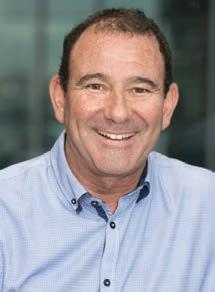
We are excited to announce that Permanent Way Institution (PWI) Australia is introducing the Fellow grade, the highest membership level within our organisation. This prestigious recognition marks a significant milestone in our commitment to fostering excellence and leadership within the transport sector.
THE VALUE OF THE PWI FELLOWSHIP
Achieving PWI Fellowship elevates your professional standing, enhances recognition of your expertise, broadens your professional networks, and acknowledges your commitment to PWI. This accolade is
more than just a title; it is a testament to our members’ dedication, skill, and leadership. Introducing this grade aims to inspire our members to strive for excellence and set a benchmark for professional achievement within the industry.
Introducing the PWI Fellowship in Australia is poised to substantially benefit the transport sector. By recognising and celebrating the highest levels of professional achievement, we are fostering a culture of excellence that will drive innovation and improvement across the industry. Fellows will be role models, inspiring their peers and the next generation of transport professionals.
Fellows will also give back to PWI for such an accolade, contributing to the growth and success of our organisation. The Fellowship provides a platform for enhanced collaboration and knowledge sharing. Fellows will engage with a network of local and international top-tier professionals. This exchange of ideas and best practices will be invaluable in addressing the unique challenges the Australian transport sector faces.
We proudly appointed our first two PWI Fellows, Neil Hobden FPWI (Aus) and David Cooper FPWI (Aus), who established the PWI Fellowship Council in Australia to review future applicants for this esteemed grade. Their leadership and commitment have been instrumental in shaping the future of the Fellowship and ensuring its ongoing impact. We would also like to acknowledge the work of Dale Smith and Stuart Sutherland of Lycopodium in supporting and developing this process. Their dedication has been crucial in bringing this initiative to fruition.
PWI originated in England and has a long history of promoting excellence in the railway industry. The introduction of the Fellowship grade in Australia aligns with our global vision of setting high standards and fostering professional growth. By adopting this prestigious grade, we are not only recognising the achievements of our members but also aligning with international best practices. This global perspective enriches our local industry, ensuring we remain at the forefront of innovation and excellence.



Are you ready to take your career to the next level and become a Fellow of PWI? This is your chance to join an elite group of professionals recognised for their outstanding contributions and commitment to the transport sector. Achieving Fellowship status is not just an honour but a careerdefining milestone that sets you apart as a leader.
At our upcoming 50th Anniversary Conference in October, we will host a dedicated PWI Fellowship discussion. This is your opportunity to learn more about the application process, meet current Fellows, and get inspired by their journeys. Don’t miss this chance to elevate your professional standing and make a lasting impact on the industry.
Can’t wait until the conference? Reach out to Neil Hobden at the PWI for all relevant
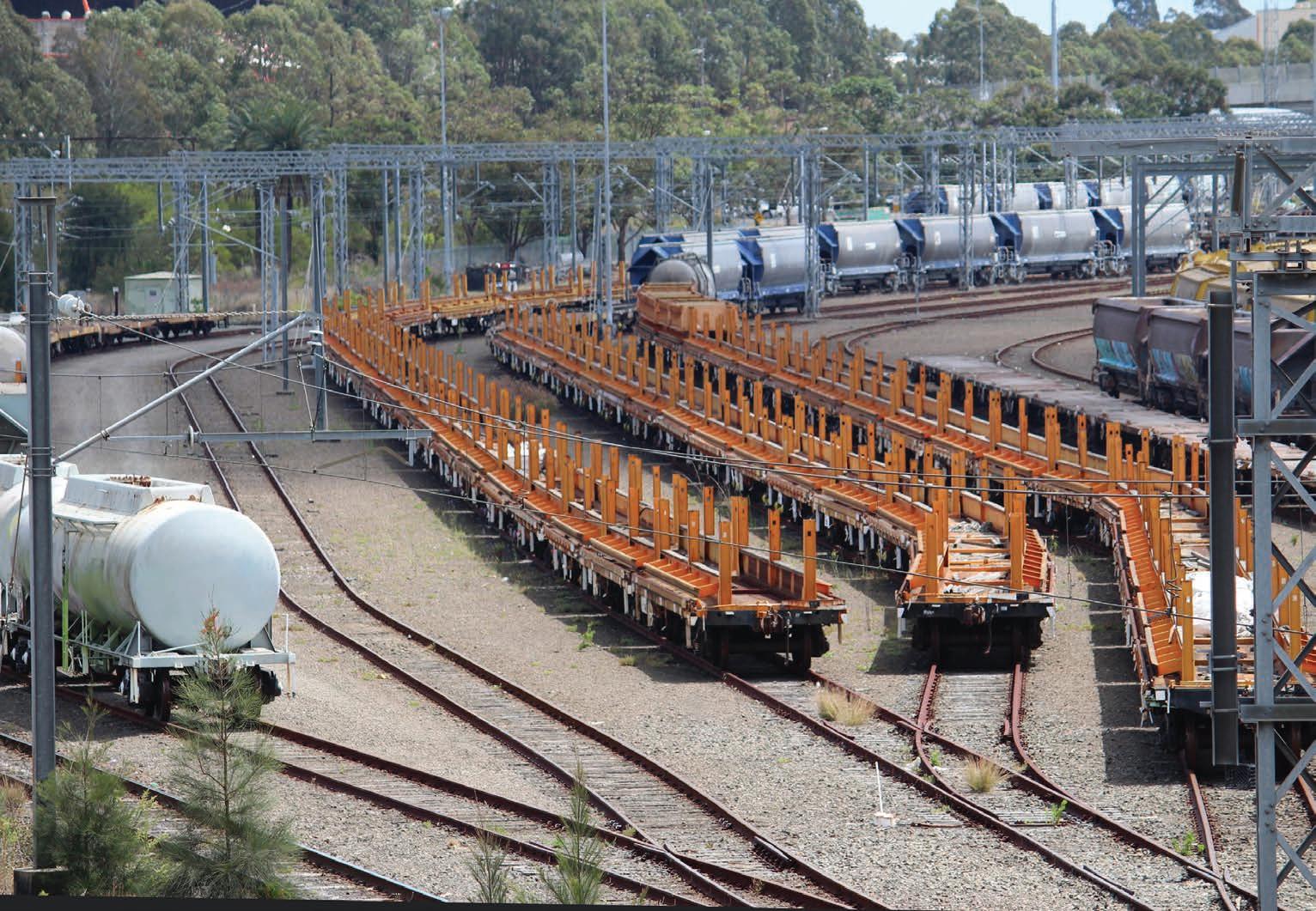
RISSB has released a white paper to explore how it can streamline the processes around rollingstock approvals across the country.
The Rail Industry Safety and Standards Board (RISSB) has released a white paper titled Streamlining the Rolling Stock Approval Processes. The paper aims to stimulate industry debate and provide a roadmap for developing more efficient, consistent and effective rolling stock approval processes across Australia’s rail networks.
Based on extensive stakeholder interviews and analysis of current practices, the discussion points and recommendations it raises are intended to spark further discussions and collaboration in the industry to achieve viable solutions.
The multiplicity of approval processes to operate rolling stock across Australia has been identified by the rail freight industry as a major deterrent to investment and innovation. Streamlining the approval processes also reduce the administrative burden with transparent timeframes that enhances rolling stock utilisation according to RISSB Chief Executive Officer Damien White.
“Over and above the safety and efficiency management perspective, it can’t be said enough that inefficient and uncertain processes create a disincentive for investment into new technologies.
Rail freight is essential to Australia’s domestic and export economies. This is the substantive business case for improvement in rolling stock approval processes,” White

The approach is for industry to collaborate.
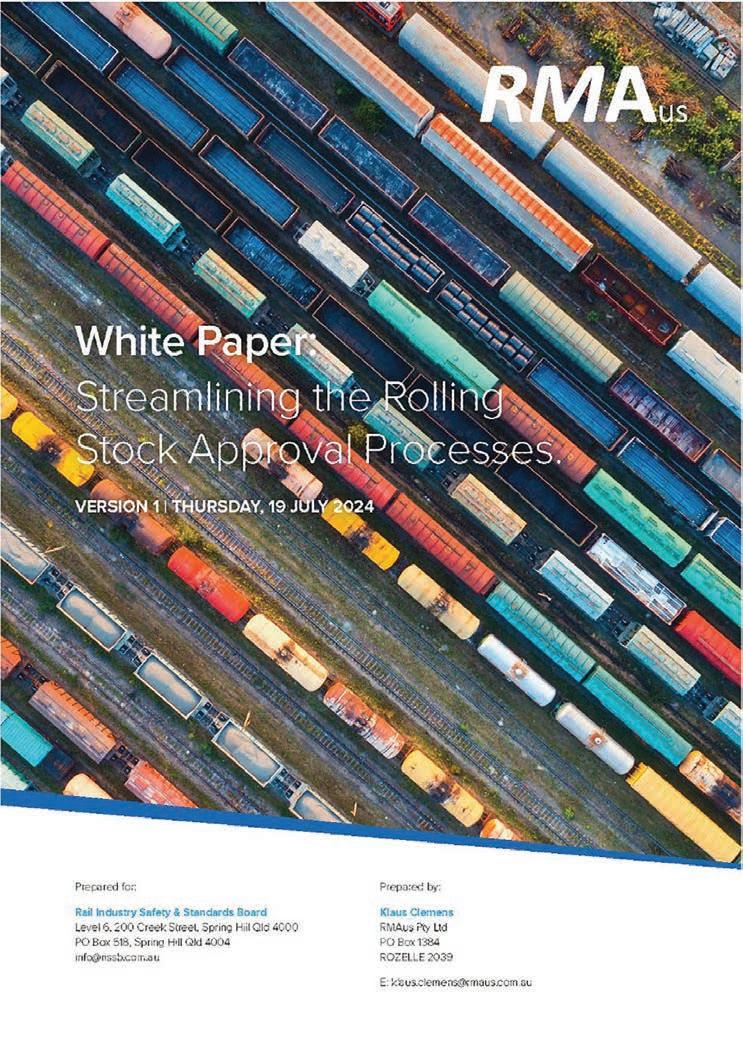
process itself, but rather with the certification
system and procedures, which will improve standardisation and enhance interoperability across the multiple interstate and intrastate networks.
RISSB invites industry to read the full report by visiting RISSB’s website and click on the ‘Products’ subheading.


The

One of the highlights of my role as RTAA president that I most look forward to is the Australasian Railway awards, and the opportunity to recognise the outstanding talent in our industry. This year it was my great pleasure to recognise our young specialist winner for 2024, Curtiss Hood of Acciona Rail.
Hood’s work on the key switch isolation method for level crossings, developed as part of the MTM Southern Program Alliance, is a demonstration of applied innovation and initiative that has a positive impact on project and system safety. A very worthy winner, and I look forward to following Hood’s career into the future.
I would also like to recognise finalists Keneith Subala, of Acciona Rail and Sasmit Dahl, of Martinus Rail. Both of your submissions were excellent and I recognise the hard work and innovation you have
displayed in your careers to date. All three of our finalists have demonstrated the depth of talent and dedication in our emerging specialists and give confidence to the future of our industry.
This of course leads naturally into questions on the future of our industry.
Over the past decade we have seen record investment, peaking at something like $1 billion a month across the country, following the old adage ‘when it rains it pours’ as this had followed years of low ‘steady state’ levels. However, these levels of capital works can be a double-edge sword.
While the levels of investment are fantastic, (and something I am personally delighted to see) this level of work and demand exposed the weakness in our workforce and resource pipelines, we simply could not find enough people, or in some cases rail, to complete the works. An enviable problem to have. We have worked together to improve training and development materials, we brought in more skilled labour from overseas all to address the shortfalls.
Then over the past 12 months, the investment taps turned down, with various state and federal projects finishing or being delayed, resulting in a significant reduction in the capital program. While this in itself is not unexpected it does have knock-on effects, particularly on the human element of
our industry. As the capital works dry up the service providers feel the pinch. In this case the constructors and engineering services. They then naturally work to safeguard their businesses by contracting to meet the new demand.
For the seasoned professionals this is nothing new and they move on to different projects or leave our shores for international opportunities. But for the juniors this is particularly impactful. They have come through university hearing about our booming industry and right when they are entering, the void opens and there are limited opportunities to enter and gain the experience they need to succeed.
This of course then feeds back down the pipeline and the interest in rail that we have so carefully built is tarnished.
Many years ago this type of issue was less of a problem as much of the initial training and development of new people was managed by monolithic government agencies, then later on after they were trained and capable, some of them split off into the private workforces and the world turned.
In the current world, with our push towards leaner agencies, this responsibility for training and development is more even spread between the private and public with all parts of the industry having to pull together to support the industry ‘need’, and emphasising the value that industry groups and associations have in co-ordinating these efforts into a cohesive whole.

All this does is help highlight the current gap in our development pipe. We have made great strides at the beginning, led by the works of the ARA with the universities to formalise rail industry into degrees. But this next step in the chain is just as important in making sure that graduates have somewhere to go to develop, and as importantly, visibly demonstrating there is a demand for them.
I am not sure what the solution is to this issue, but I do know that if we don’t work together to find one then when the next wave of demand hits us, be it from investment in Metro, High speed rail or even just ageing workforces, we will once again be on the back foot and have to race to close the gap.

GOLD COAST LIGHT RAIL STAGE FOUR DETAILED PLANNING STAGE
Stage Four (previously Stage 3B) will extend the Gold Coast light rail network from where the planned Stage 3 (previously Stage 3A) ends at Burleigh Heads to Coolangatta via the Gold Coast Airport.
The detailed project scope and route will be determined through the business case development process. Broadly, the scope involves:
• 13 kilometres of dual light rail track
• improved Palm Beach Avenue precinct
• improved connectivity to the M1 via Nineteenth Avenue
• active transport developments along the line
• improvements to the Palm Beach Avenue precinct
• changes to Tugun Village access for safety and traffic flow improvements, and
• wildlife crossings.
The route will include nine stations between Burleigh Heads and Tugun, with further stations to be investigated between Tugun to Coolangatta.
Once delivered, Stage Four will complete a 40 kilometre light rail link between Helensvale in the north to Coolangatta in the south, via the Gold Coast Airport.
BRISBANE METRO - WOOLLOONGABBA STATION ANNOUNCED
A$450 MILLION
As part of the South East Queensland (SEQ) City Deal, the Federal Government, Queensland Government and Brisbane City Council announced $450 million for a new Woolloongabba Brisbane Metro Station.
Metro into the Woolloongabba precinct

and improve linkages with Cross River Rail. The scope of the new Woolloongabba Brisbane Metro Station includes:
• a new underground station and busway connections
• bus layover facilities
• upgrades to local roads and intersections, and
• pedestrian, cycle and urban realm improvements within the precinct.
Detailed planning and design will progress over the next two years.
NEW ZEALAND
NORTH AUCKLAND RAIL LINK TO NORTHPORT
DETAILED PLANNING STAGE
Through a re-evaluation of the New Zealand Upgrade Program (NZUP), the NZ Government has proposed a rail link providing additional rail connectivity in the Northland region.
The program will aim to encourage freight to be carried by rail instead of road by providing a freight rail connection to Northport.
The indicative route of the NZUPfunded project, designated in 2012, is approximately 19 kilometres and will run between North Auckland Line in Oakleigh, south of Whangarei, and Marsden Point in Northport. The rail corridor width is expected to future proof for double tracking, with five road crossings on this route to be grade separated.
Separate funding has been allocated to reopen the currently mothballed line between Kauri (just north of Whangārei) and Otiria, and to build a rail/road transfer site at Otiria. Alongside this, additional NZUP
LOWER NORTH ISLAND RAIL INTEGRATED MOBILITY PROGRAM UNDER PROCUREMENT
A$891 MILLION
The Lower North Island Rail Integrated Mobility Program includes the delivery of 18 new trains and infrastructure improvements to the Wairarapa and Manawatu lines, station improvements, and delivery of a maintenance depot in Masterton.
NEW SOUTH WALES
SYDNEY METRO – WESTERN SYDNEY AIRPORT – STAGE TWO DETAILED PLANNING STAGE
The proposed Sydney Metro – Western Sydney Airport (WSA) – Stage Two project would extend the WSA metro line from the end of first stage at Bradfield to Glenfield, via Leppington.
VICTORIA MELTON LINE UPGRADE ANNOUNCED
A$650 MILLION
The Melton Line Upgrade is an upgrade to existing rail infrastructure in West Melbourne. The scope of the project includes enhanced stabling works and improved stations to accommodate nine-car VLocity Trains.
The project includes:
• a new Melton Station with four platforms with pedestrian walkways, cycling paths, pick-up and drop-off zones, and lifts and stairs to each platform
• new rail bridges over Coburns and Exford roads, and
• new road over rail bridges at Ferris Road and Hoplins Road.
The project scope includes investigation
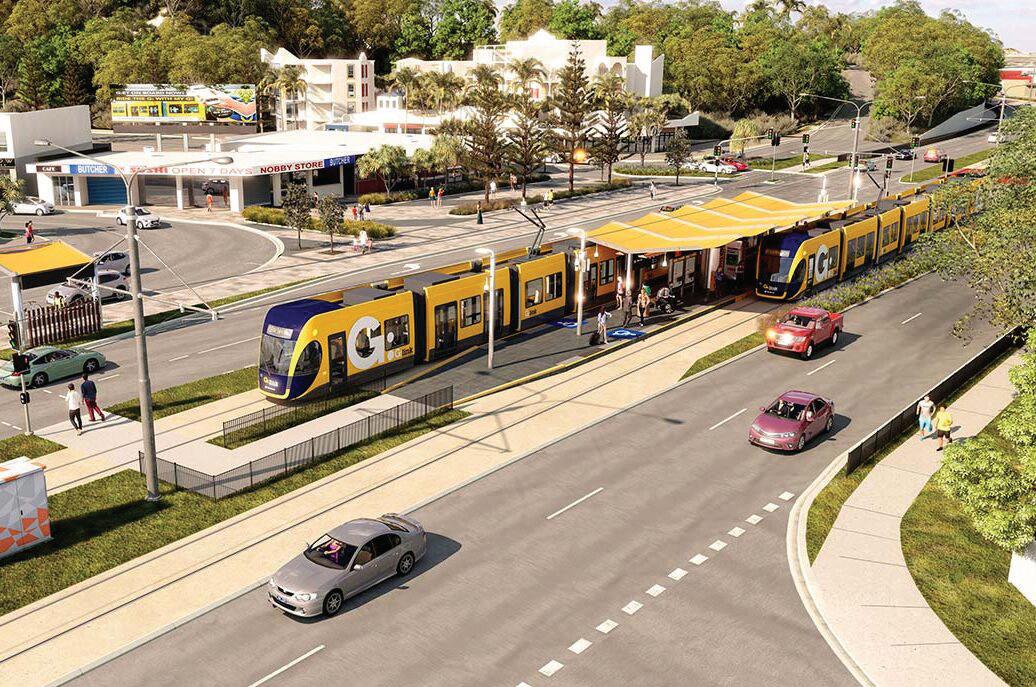

ompulsory reading and a vital tool ng in and around the rail sector.


Rail Express is Australia’s authoritative business to business rail publication.
Combining the resources of our respected journalism team Rail Express provides extensive, comprehensive and balanced coverage of breaking news and trends in key areas like infrastructure, investment, government policy, regulatory issues and technical innovation.
Published both in print and digitally every month, Rail Express is active participation of the main railway associations in Australia and the broad support of the rail industry.
The only way to ensure you get every copy of Rail Express is to subscribe today. Visit railexpress.com.au/subscribe.

We’re the leading provider of end-to-end rail and transport solutions in Australia and New Zealand. From designing and constructing transport networks to operating them, we’re transforming the way people travel and providing better connections across the country.
Every day, more than one million passengers journey are taken on our networks. Our longstanding experience in mass transport means we know how to put together the right solution - from start to finish. Focused on the future of transport, we innovate today for the best outcomes tomorrow. From digital engineering to digital asset management, to targeting zeroemission transport modes; we’re in it for the long haul.



